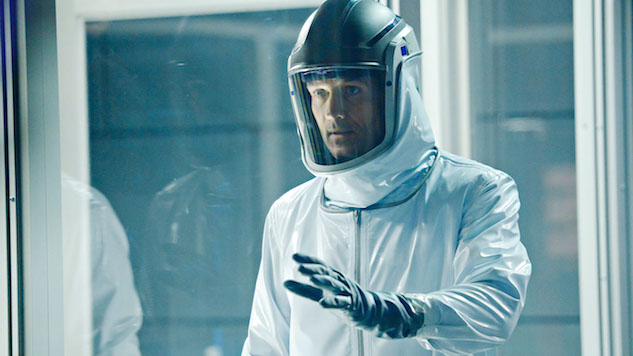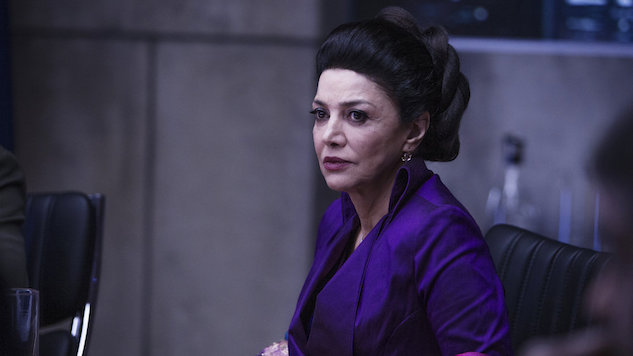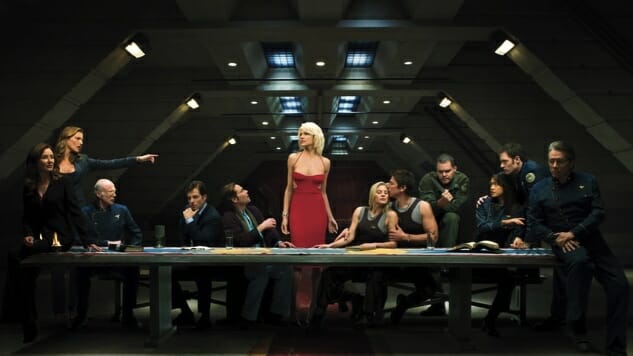
Science-fiction has been broadcast in the U.S. since the early days of television, with kids’ programs like Captain Video and His Video Rangers in 1949 and Space Patrol in the 1950s. But it was really Gene Roddenberry’s groundbreaking 1966 series Star Trek that would forever shape what was to follow. And while we still haven’t had the sci-fi big-budget prestige TV equivalent of fantasy’s Game of Thrones, we’re getting closer all the time with shows like HBO’s Westworld, Netflix’s Altered Carbon and Amazon’s takeover of The Expanse getting full support from their respective networks.
From time-travel to alien encounters to the possibilities of new technologies, the steady march of human progress would be colored by what we can imagine on screen. The shows here range from hard sci-fi and gritty space operas to silly sitcoms and animated series. We were surprised at how quickly we got to 100 and how many sci-fi shows didn’t fit on this list. There’s never been more sci-fi shows airing on TV, and if quantity doesn’t always mean quality, there’s plenty for the sci-fi fan to love right now.
Here are the 100 best sci-fi TV series of all time:
100. Sliders (1995-2000)
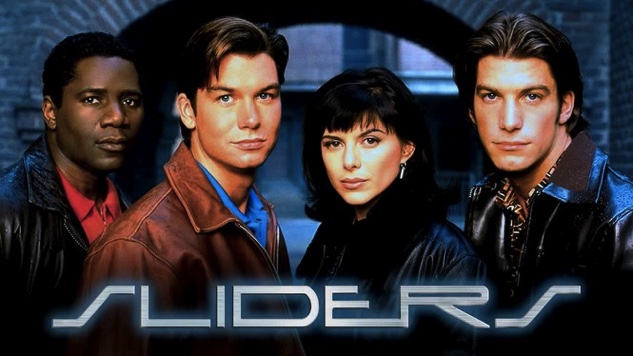
Creator: Tracy Tormé, Robert K. Weiss
Stars: Jerry O’Connell, Cleavant Derricks, Sabrina Lloyd, John Rhys-Davies, Kari Wuhrer, Charlie O’Connell, Robert Floyd, Tembi Locke
Network: Fox/Sci-Fi
This five-season Fox/Sci-Fi series used wormholes to travel, at random, across parallel universes (in the vein of other randomized episodic scifi, Quantum Leap and Voyagers). Always trying to slide home (get it?), Jerry O’Connell’s Quinn leads his group of travelers from parallel Earth to parallel Earth in what can charitably be called an exercise in WTF. Their eventual arch-enemies, the Kromags, even built an empire by slide-conquering hundreds of these parallel worlds. —JD Jordan
99. Extant (2014-2015)
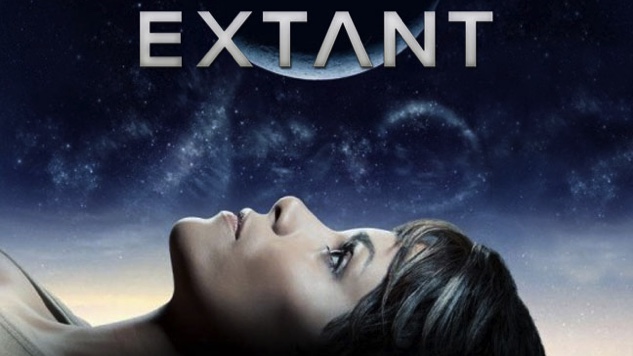
Creator: Mickey Fisher
Stars: Halle Berry, Goran Visnjic, Pierce Gagnon, Jeffrey Dean Morgan, Hiroyuki Sanada, Camryn Manheim, Grace Gummer, Michael O’Neill
Network: CBS
The premise of Extant is John Updike does Rosemary’s Baby, except the demon child is already born. Among the many differences is this: Rosemary was violated; Molly was hypnotized. The conception incident here evokes longing, not recoil; confusion, not disorientation. It’s played like a hallucination—though it wasn’t—but because this fertile entity borrows the form of Molly’s dead first husband, Marcus, the scene speaks for the pilot: Who we let in has so very little to do with us. Ethan (Pierce Gagnon) is Daddy’s pride and joy: The prototype for a new wave of unhuman humans. John Woods (Goran Visnjic) engineered the boy when he and Molly (Halle Berry) couldn’t conceive and were denied adoption. His affection for Ethan surpasses inventor-invention, but it’s hard to tell if that’s the human experience working or the product. He presents Ethan to a powerful technology board and exhausts the importance of integration. These are not sophisticated slaves, but a new breed of people. He grows defensive toward their questioning. Passion and foolishness are more closely related than he and Ethan. The tension is drummed up intentionally. The point of the show is to inspire uneasiness in the viewer. Creator Mickey Fisher seems to want this show to ask, What does it mean to be real? John assures Ethan he is a person. Ethan disagrees. This is a thing. In addition to its artificial intelligence-son-alien-fetus cleverness, Fisher has sketched thoughtful inquiries into how and why we love. —Kyle Burton
98. Voyagers! (1982-1983)
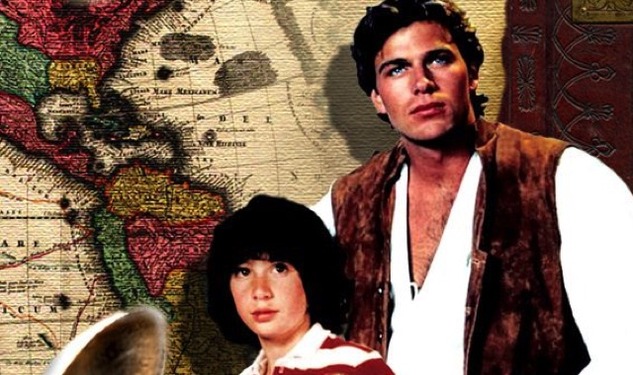
Creator: James D. Parriott
Stars: Jon-Erik Hexum, Meeno Peluce
Network: NBC
Considered a precursor to Quantum Leap, Voyagers! only ran for a single season, but the short-lived ‘80s time travel series remains a cult favorite to this day. Jon-Erik Hexum played Phineas Bogg, and was part of a team of time travelers dedicated to ensuring that history stayed on track, which meant lots of run-ins with famous historical figures for Bogg and his kid sidekick, as the pair traveled across the centuries. They were sort of like Bill and Ted, minus the impromptu bouts of air guitar. But as a family-friendly show that successfully mixed time travel hijinks with history lessons, it’s still difficult to believe Voyagers! didn’t get a longer run. —Rick Mele
97. Almost Human (2013)
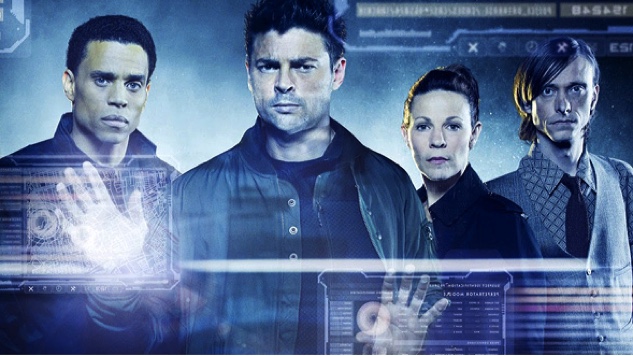
Creator: J. H. Wyman
Stars: Karl Urban, Michael Ealy, Minka Kelly, Mackenzie Crook, Michael Irby, Lili Taylor
Network: Fox
The J.J. Abrams-produced Almost Human debuted on Fox with a bit of baggage (a co-showrunner departing because of “creative differences,” a delayed premiere), and it was canceled after just one season. But the show itself was a solid, albeit generic, sci-fi experiment, anchored by a charming, odd-couple pairing that prevented it from taking a nosedive into boresville. After a white-on-black title card informs us that, in the year 2048, a 400% increase in crime rate resulted in the overwhelmed L.A. police force partnering each officer with a combat-model android, we’re thrown headfirst into a futuristic alley battle that feels straight out of a videogame cut scene (in a good way). As gunfire and explosions go off all around him, officer John Kennex (Karl Urban) watches in horror as his entire unit, including his partner, is mowed down by the members of a nefarious criminal organization called the Insyndicate. We then move forward to present day where we learn that the events of the attack put Kennex in a 17-month coma and left him with a synthetic leg to replace the one that was blown off. Despite suffering from all manner of scars, both mental and physical, Kennex returns to the job after hearing that the Insyndicate has resurfaced. Against his own wishes, he’s given the mandated android partner. After unceremoniously tossing his first new partner out of the police cruiser, Kennex goes to robot maker Rudy Lom (Mackenzie Crook) for a last-minute replacement. Here, he’s granted a slightly unorthodox partner in the form of Dorian (Michael Ealy), a DNR model. Unlike the current crop of androids, which operate purely on logic and reasoning, the DNR were designed to actually replicate human emotions. Surprisingly, few others in the precinct seem to question or care why Kennex drags in such an outdated model. Over 13 episodes, there’s much to admire in the creativity of the writing staff in coming up with offbeat, yet surprisingly grounded cases to augment the show’s futuristic world. The series finale showed how far Almost Human had come and how much more it could potentially have offered. —Mark Rozeman
96. Knight Rider (1982-1986)
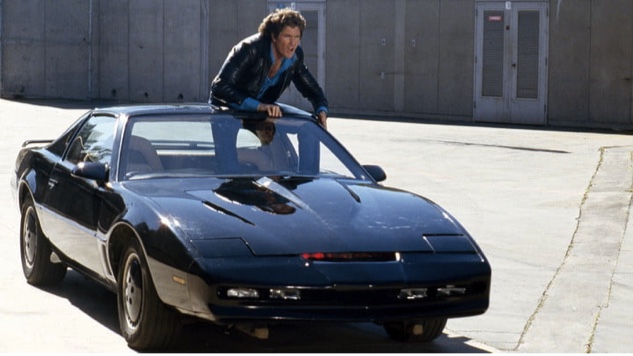
Creators: Glen A. Larson
Stars: David Hasselhoff, William Daniels, Edward Mulhare, Patricia McPherson
Network: NBC
Artificial intelligence was never as cool before or since the creation of KITT, Michael Knight’s partner in the Foundation for Law and Government (FLAG). KITT, a souped up Trans Am, didn’t need a driver and was outfitted with enough gadgets to make James Bond jealous. Created and often written by Glen A. Larson (whose credits include Battlestar Galactica, Quincy, M.E., The Fall Guy, Magnum, P.I.), there were always plenty of bad-guy plans to foil in exceedingly awesome manners. —Josh Jackson
95. Land of the Lost (1974-1976, 1991-1992)

Creator: Sid & Marty Krofft, Allan Foshko
Stars: Spencer Milligan, Wesley Eure, Kathy Coleman, Phillip Paley, Ron Harper
Network: NBC
There’s much to love about the large-scale adventure and unabashed cheesiness of Land of the Lost. When a mysterious, dimensional portal brings the Marshalls to an alternate universe populated by dinosaurs, primates and other creatures, the family must find a way to survive and make their way back home. Luckily, the monsters are about as scary as the tyrannosaurus Gorn from Star Trek: The Original Series. Land of the Lost’s special effects team brought all non-human creatures to life with actors in rubber suits and heavy makeup, stop-motion animation miniatures, hand puppets, rear projection film effects and video blue-screen matting. Many of these effects can be seen in the series’ lovably corny, action-packed opener. Our favorite: the river-rafting scene, with the poor little bobbing blue-screen raft. Hang in there, Marshalls! —James Charisma
94. Journeyman (2007)
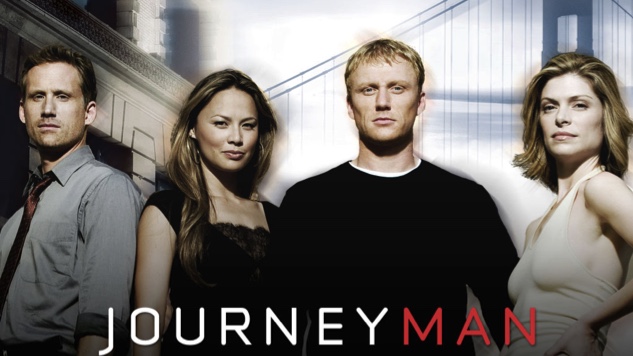
Creator: Kevin Falls
Stars: Kevin McKidd, Brian Howe, Gretchen Egolf, Moon Bloodgood, Reed Diamond, Charles Henry Wyson
Network: NBC
Journeyman was something of a modern-day reincarnation of Quantum Leap, starring Kevin McKidd as a San Francisco reporter who finds himself unexpectedly traveling through time in order to change various character’s futures for the better, while struggling to explain his sudden disappearances to both himself and his family. Low ratings and the 2007 Writers Guild strike led to NBC canceling the fledgling sci-fi romance after only 13 episodes—much to the disappointment of Journeyman’s small but loyal following (count 12 Monkey’s co-creator Terry Matalas among them). The show’s fans attempted to pull a Jericho, sending Rice-a-Roni to the NBC offices in hopes of saving the series, but unfortunately, the last-minute hail mary didn’t work. —Rick Mele
93. Jake 2.0 (2003-2004)
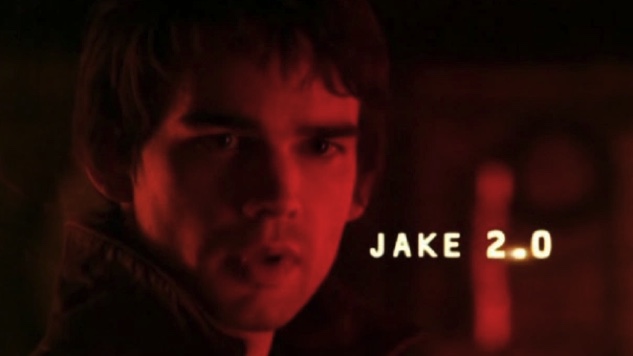
Creator: Silvio Horta
Stars: Christopher Gorham, Philip Anthony-Rodriguez, Judith Scott, Marina Black, Keegan Connor Tracy
Network: UPN
Before Chuck, there was Jake 2.0. The similar concept was as follows: Your normal, everyday computer genius gets infected with nanorobots and gains superhuman abilities. The show starring Christopher Gorham (Covert Affairs) aired on UPN for only 10 episodes before being canceled due to low ratings. While the network wasn’t really known for high quality entertainment (besides the genius Veronica Mars, which moved to the CW following a merger with the WB), the show had an intriguing concept that was never fully realized. —Shaina Pearlman
92. Terra Nova (2011)
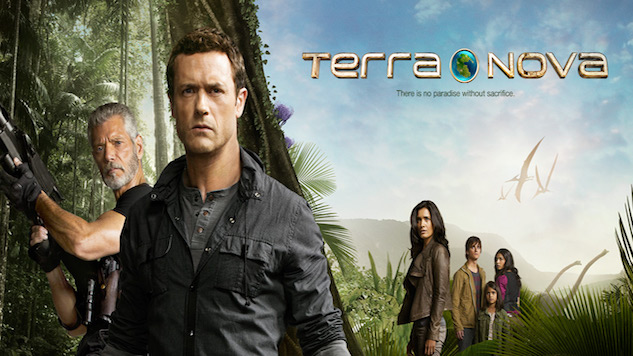
Creator: Kelly Marcel, Craig Silverstein
Stars: Jason O’Mara, Shelley Conn, Stephan Lang, Christine Adams,
Network: FOX
Steven Spielberg, dinosaurs and time travel sounds like about as airtight a pitch as they come, and the future was looking bright for the Spielberg-produced Terra Nova in fall 2011. The premise was strong—a group of pilgrims leave an overpopulated and dying Earth in 2149, to travel back some 85 million years for a second try at civilization. And the show was given a massive budget to ensure the special effects and CGI dinos were up to snuff. Life of Mars star Jason O’Mara was also given another shot, headlining his own time-travel show. Unfortunately, things didn’t go much better for O’Mara the second time around: history would repeat itself, and the time-travel adventure series was shelved after only 13 episodes. But while an uneven first season and that high per-episode price tag put an end to Fox’s prehistoric experiment, with all the elements Terra Nova had going for it, it’s hard to imagine the show wouldn’t have gotten better if it’d been afforded another season to find its legs. —Rick Mele
91. Clone High (2002-2003)
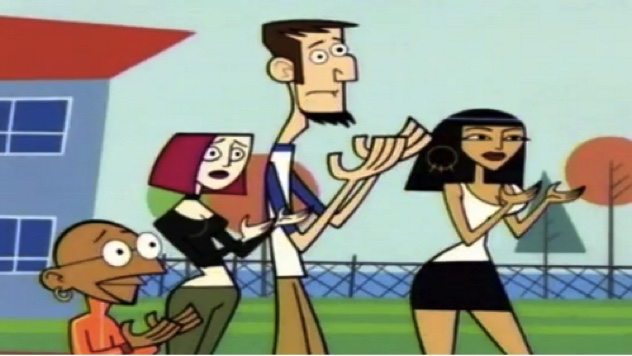
Creators: Phil Lord, Christopher Miller, Bill Lawrence
Stars: Will Forte, Nicole Sullivan, Michael McDonald, Christopher Miller, Christa Miller, Phil Lord
Network: Teletoon, MTV
The genius premise of Clone High is quickly explained in its 30-second intro, in which the U.S. military and shadowy government officials extract the DNA of deceased figures from history and genetically recreate them in the form of angsty high schoolers. Our protagonist is Abe Lincoln, a lanky, awkward clone of our 16th president, who struggles with the challenges of adolescence as well as living up to his “clonefather.” As he vies for the affection of popular Cleopatra against the arrogant jock JFK, his best friends include the politically liberal Joan of Arc and party animal Gandhi. Everything about the series was destined for both a short lifespan and eventual cult status. It succeeded at both: For 13 glorious episodes, we had Clone High, the perfect parody of network teen dramas. —James Charisma
90. The Adventures of Brisco County, Jr. (1993-1994)
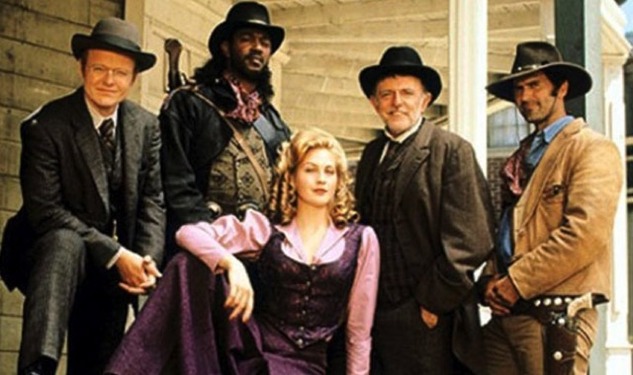
Creator: Jeffrey Boam, Carlton Cuse
Stars: Bruce Campbell, Julius Carry, Christian Clemenson
Network: Fox
Fresh off Army of Darkness, which sent Bruce Campbell back to medieval times, the Evil Dead star jumped aboard this anachronistic Western with a sci-fi twist from future Lost showrunner Carlton Cuse and former Lost Boys and Indiana Jones and the Last Crusade writer Jeffrey Boam. The genre-blending series was goofy and weird, complete with a mysterious futuristic orb, a time-traveling bad guy and irreverent sense of humor. But despite favorable reviews and strong initial ratings, The Adventures of Brisco County, Jr. was doomed from the start by its Friday night time slot, destined to become yet another cult favorite lost to time, after being completely overshadowed by one of Fox’s other new shows: The X-Files. And while it’s hard to argue with the network picking the adventures of Mulder and Scully over a bounty-hunting Bruce Campbell, it still would have been interesting to see what the combo of Cuse, Boam and Campbell could have resulted in with another season and a better time slot. Or, maybe we would’ve just gotten the Smoke Monster and polar bears in the Old West. It’s hard to say. —Rick Mele
89. Buck Rogers in the 25th Century (1979-1981)

Creators: Glen A. Larson, Leslie Stevens
Stars: Gil Gerard, Erin Gray, Pamela Hensley, Tim O’Connor, Felix Silla, Mel Blanc
Network: NBC
Gil Gerard’s Buck—a hero only the 1980s could love—was a more chauvinistic and more Steve Austin-like version of a Han Solo who started out flying a retooled rebel snow speeder in defense of the Earth. His never-quite-romantic relationships with Erin Gray’s Wilma Deering or Pamela Hensley’s Princess Ardala were the thing of macho fantasy, never mind his daring in the cockpit or at un-choreographed TV fisticuffs. Star Wars’ influence is heavy on this show, but it’s only in his second season (1980-1981) that Buck took flight in the Searcher with his mixed bag of heroes, a transition that more closely emulated creator Glen Larson’s other ’80s TV franchise, Battlestar Galactica. —Ellie Decker & JD Jordan
88. seaQuest DSV (1993-1996)

Creator: Rockne S. O’Bannon
Stars: Roy Scheider, Jonathan Brandis, Stephanie Beacham, Don Franklin, Michael Ironside
Network: NBC
It’s easy to sort of deride seaQuest DSV as essentially “Star Trek underwater,” but in its earlier episodes that comparison was only half right. Roy Scheider of Jaws fame starred as the captain of a research and diplomatic envoy vessel in a future where depletion of the Earth’s resources has led to the only cities remaining underwater, where they harvest the bounty of the ocean. As the show progressed to a second season, the sci-fi elements grew stronger with the discovery of aliens and various “monster of the week” episodes in the vein of those types of Star Trek or X-Files episodes. Scheider was particularly unhappy about the direction the show was heading and stepped down before the third season, which was oddly set 10 years further into the future. Michael Ironside replaced him and played the new, more militaristic captain, but ratings were bad, dooming one of network TV’s quirkier series. —Jim Vorel
87. Final Space (2018-)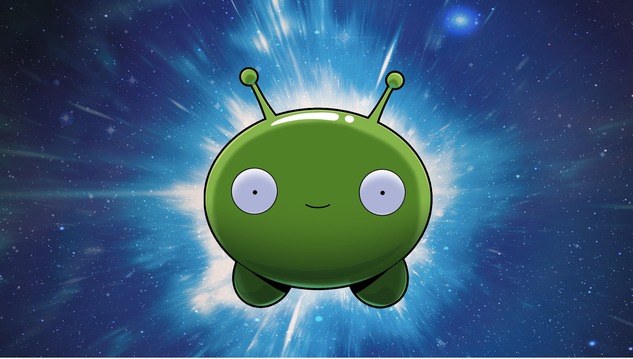
Creator: Olan Rogers
Stars: Olan Rogers, Fred Armisen, Tom Kenny, David Tennant, Tika Sumpter, Steven Yeun, Coty Galloway, Caleb McLaughlin, Ron Perlman, John DiMaggio, Gina Torres, Shannon Purser, Keith David, Andy Richter, Conan O’Brien, Xzibit
Network: TBS
Mooncake is the most adorable super weapon in the galaxy. Olan Rogers’ series about a self-deluded astronaut who’s serving out the final days of a prison sentence is surprisingly touching and creatively plotted for an animated comedy. With Conan O’Brien as an executive producer and a supporting cast that includes Fred Armisen, David Tennant and Steven Yeun, there’s plenty of star power, but this is Rogers’ show, as he also voices both lead character Gary Godspeed (and his mostly silent, planet-destroying alien friend Mooncake). He’s brave, loyal, mostly incompetent and completely self-deluded, but he’ll stop at nothing to help his friend Avacato and the object of his infatuation, Quinn, as they save the universe from the evil Lord Commander. Final Space returns for a second season and more adventure in 2019. —Josh Jackson
86. Primeval (2007-2011)
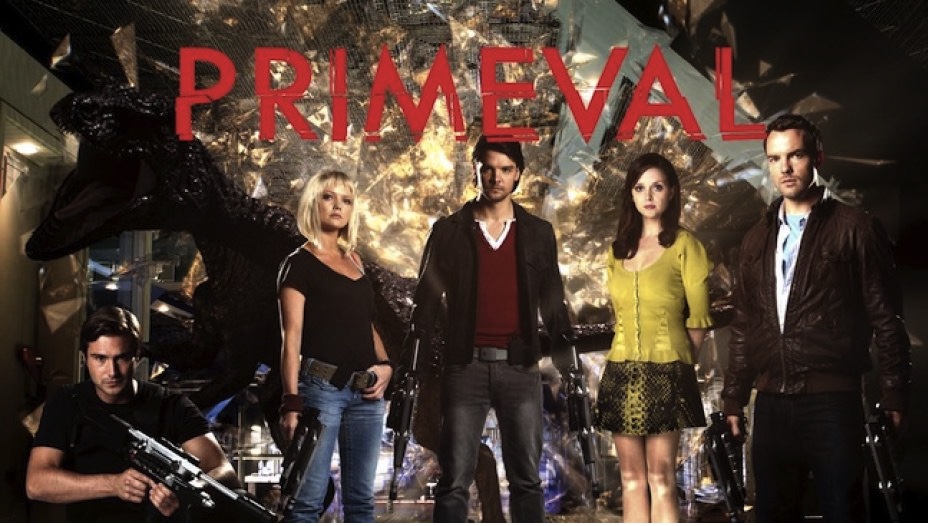
Creators: Adrian Hodges, Tim Haines
Stars: Douglas Henshall, James Murray, Andrew-Lee Potts, Lucy Brown, Hannah Spearritt, Juliet Aubrey, Ben Miller
Network: ITV
British sci-fi series Primeval taps into our enduring fascination with dinosaurs, but things got more interesting for the show when the time-travel started happening in both directions. The team encounters a future where super-powerful humanoid predators and just-as-scary giant insects have eradicated all of humanity. For a show that had been parading creatures from the past (dinosaurs, aquatic reptiles, flocks of dodos) into the present, this twist saved it from feeling too much like its creators’ Walking With the Dinosaurs programs. Humans, it turns out, had a hand in creating the predators, and different moral conclusions about how to stop the coming apocalypse led to much of the show’s main tensions. A British-Canadian spin-off, Primeval: New World only lasted one season. —Josh Jackson
85. Falling Skies (2011-2015)
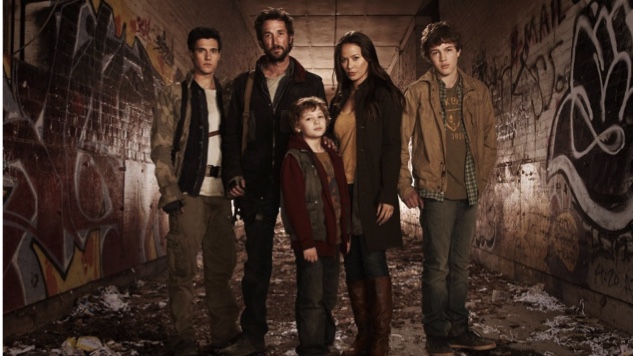
Creator: Robert Rodat
Stars: Noah Wyle, Moon Bloodgood, Drew Roy, Jessy Schram, Maxim Knight, Seychelle Gabriel, Peter Shinkoda, Mpho Koaho, Connor Jessup, Will Patton, Sarah Carter, Colin Cunningham, Doug Jones, Scarlett Byrne
Network: TNT
When the alien apocalypse comes, even mild-mannered history professors must fight back. Noah Hawley stars as Tom Mason, part of the 2nd Massachusetts Militia Regiment (Second Mass) in the resistance to our space invaders, the Skitters, who’ve destroyed Earth’s cities and power grids. Saving Private Ryan scribe re-teamed with executive producer Steven Speilberg to build a world in which the aliens are clearly winning and taking over the minds of our children through a biomechanical harness. As the series progressed, more alien species are introduced on both sides of the war for our planet. The show lasted five seasons, allowing Rodat to develop the characters, explore themes of family, solidarity and heroism, and tell the full story of Earth’s resistance. —Josh Jackson
84. The Six Million Dollar Man (1973-1978)
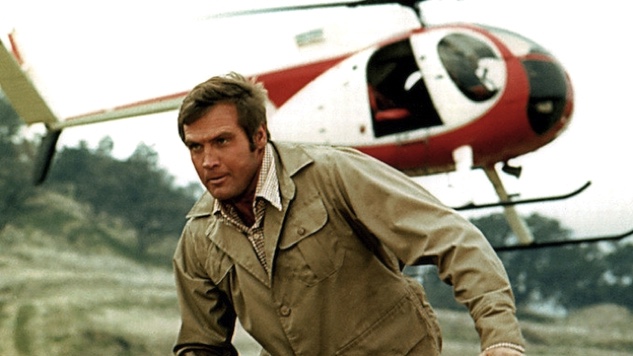
Creator: Martin Caidin
Stars: Lee Majors, Richard Anderson, Alan Oppenheimer, Martin E. Brooks
Network: ABC, NBC
“We can rebuild him. We have the technology. We can make him better than he was. Better…stronger…faster.” Just about everyone with exposure to Western television is familiar with the famous opening narration that began every episode of The Six Million Dollar Man. Astronaut Steve Austin (in a time when we still loved our space program and astronauts were heroes) crashes in an experimental craft and is rebuilt by the secretive Office of Scientific Intelligence. With new enhanced legs, right arm and left eye, Austin is reborn as a secret agent who uses the abilities granted by his prosthetics to basically become cyborg James Bond, complete with some of the earliest (effective) uses of slow motion scenes in combat, before they became the cliché they are today. —K. Alexander Smith
83. The Bionic Woman (1976-1978)
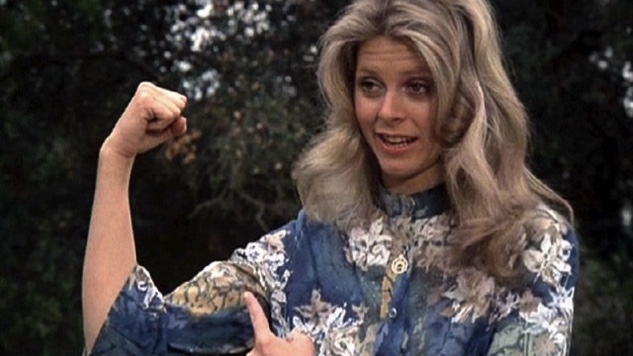
Creator: Kenneth Johnson
Stars: Lindsay Wagner, Richard Anderson, Martin E. Brooks
Network: ABC
A spin-off of The Six Million Dollar Man, The Bionic Woman replaced Lee Majors with Lindsay Wagner as Jaime Sommers, a professional tennis player and girlfriend of Steve Austin, who undergoes a similar operation to replace parts of her damaged body (a skydiving accident) with super-powered prosthetics. Teaching middle-school kids as a cover, Jaime works for the same secret organization as her less expensive ex (the show was called The Seven Million Dollar Woman in Germany), using her super speed, strength and hearing to bring down the bad guys. The show’s global success should have paved the way for more women-centric superhero movies and shows, but studio executives aren’t always blessed with super smarts. —Josh Jackson
82. Terminator: The Sarah Connor Chronicles (2008-2009)

Creator: Josh Friedman
Stars: Lena Headey, Thomas Dekker, Summer Glau, Brian Austin Green, Garret Dillahunt, Shirley Manson, Richard T. Jones, Leven Rambin
Network: Fox
Much in the same as Syfy’s 12 Monkeys, the idea of turning a beloved time travel film into sci-fi TV fodder seemed like sacrilege at first, but thanks to time-traveling Schwarzeneggers, the Terminator franchise’s timeline has been able to withstand multiple sequels, reboots and this short-lived TV show with no ill effects. (Plus, creator Josh Friedman quickly got in fans’ good graces by completely erasing the events of Terminator 3.) Starring a pre-Game of Thrones Lena Headey as Sarah Connor, Thomas Dekker as mankind’s last, best hope and Summer Glau as another reprogrammed cyborg, the show follows the trio as they jump forward to 2007, pushing Judgment Day back to April 21, 2011. And for a while, at least, it seemed like it would stick—reviews were strong, ratings were high and it was renewed for a second season. But the series’ own Judgment Day would come on May 18, 2009, when the show wasn’t renewed for a third, despite fan outcry. Instead, the powers that be decided they’d rather return the Terminator story to the big screen—although after the reviews for Terminator Salvation (and Terminator Genisys), it looks like they would’ve been better off just keeping The Sarah Connor Chronicles going. Still, that does set up a potentially tricky butterfly effect: if this show had become a big hit, Lena Headey might have never gone on to Westeros instead… —Rick Mele
81. Mars (2016-)

Creators: Brian Grazer, Ron Howard and Michael Rosenberg
Stars: Ben Cotton, Jihae, Sammi Rotibi, Clementine Poidatz, Anamaria Marinca
Network: Nat Geo
We have a never-ending fascination with Mars. Is there life there? Can we send an astronaut? The planet has been fodder for countless documentaries and imaginary tales. This six-part miniseries stands out as a hybrid by interspersing the fictional story of the first mission to Mars in 2033 with interviews with Mars experts including Andy Weir (author of The Martian), Neil deGrasse Tyson, and NASA administrator Charles Bolden. TV is constantly reinventing itself, and this fusion of fiction with reality could spawn a whole new genre. (The series returns for a second season in fall 2018). —Amy Amatangelo
80. 3rd Rock from the Sun (1996-2001)
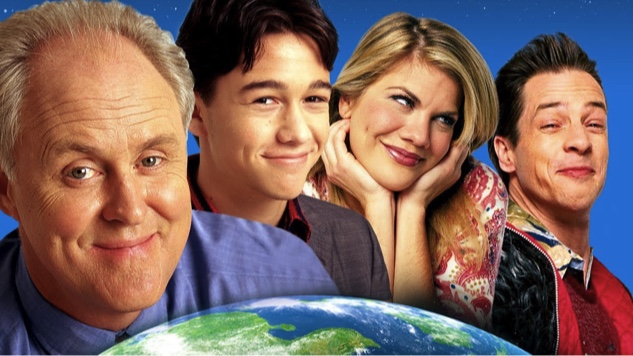
Creators: Bonnie Turner, Terry Turner
Stars: John Lithgow, Kristen Johnston, French Stewart, Joseph Gordon-Levitt, Jane Curtin, Simbi Khali, Elmarie Wendel, Wayne Knight
Network: NBC
3rd Rock successfully took the Mork & Mindy premise and expanded it to an entire family unit of aliens who land on Earth and attempt to study mankind by blending in among them. There wasn’t much here that you would call “highbrow humor,” but the strong cast always made the best of things, especially Jonathan Lithgow as frenzied High Commander Dick Solomon and future A-lister Joseph Gordon-Levitt as Tommy. Later seasons saw the aliens become more interested in their human lives than the mission at hand, and even had the bonus of appearances by the family’s supreme commander, “The Big Giant Head,” played by William Shatner. You gotta love the dual references to The Twilight Zone and its film adaptation that Shatner and Lithgow share in this scene. —Jim Vorel
79. Humans (2015-)

Creator:
Stars: Manpreet Bachu, Emily Berrington, Ruth Bradley, Lucy Carless, Gemma Chan, Pixie Davies, Jack Derges, William Hurt, Marshall Allman, Sonya Cassidy, Carrie-Anne Moss
Network: AMC, Channel 4
This AMC series is reminiscent of both Ex Machina and Westworld with a story framed around the invention of “synths,” anthropomorphic robots, and the impact they have on the human world. Humans tackles some heavy themes, including memory, personhood, human (and non-human) rights and the fear of things we may not understand. Some of it is well-mined sci-fi territory, but Humans puts a fresh spin on the themes you might remember from old Twilight Zone re-runs. It also features an impeccable cast, led by Gemma Chan, William Hurt and a few others, who turn in some of the most human (and sometimes spooky) performances you’ll see anywhere on TV. The show is actually a remake of a Swedish series, and is one of the few remakes that manage to meet (and sometimes exceed) the quality of the original. —Trent Moore
78. Defiance (2013-2015)
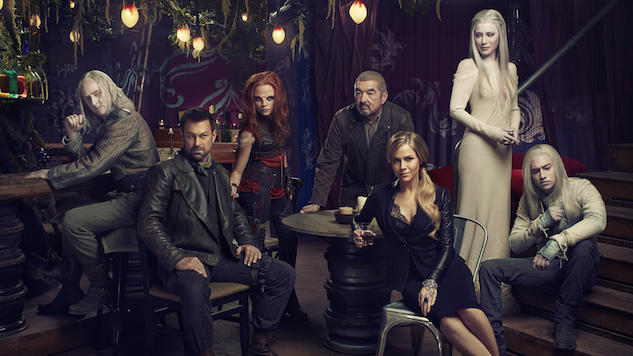
Creators: Rockne S. O’Bannon, Kevin Murphy, Michael Taylor
Stars: Grant Bowler, Julie Benz, Stephanie Leonidas, Tony Curran, Jaime Murray, Graham Greene, Mia Kirshner, Jesse Rath
Network: SyFy
Defiance was ambitious, a key to any TV show filled with aliens and spaceships. In the near future, seven alien races collectively known as the Votans traveled thousands of years to Earth, not knowing it was inhabited. While some colonists were allowed to settle, the bulk of the refugees remained in stasis on their ships while humans and Votans negotiated for their settlement. When the ships were mysteriously destroyed, the Pale Wars broke out and alien terraforming technology was chaotically unleashed upon the planet, reshaping the landscape and introducing dangerously altered creatures from the Votans’ home worlds. It’s a well-developed backstory, complete with languages developed for the Castithan and Irathiant races by David J. Peterson, the same linguist who created the Dothraki language for Game of Thrones. Grant Bowles stars as Joshua Nolan, a former marine who makes his living scavenging Arkfalls, the scraps of alien transport ships that periodically drop like meteors into the earth, destroying whatever is in their path but providing technology to the highest bidders. But in the pilot, he finds himself thrust into the role of sheriff of Defiance, a common trope in sci-fi shows (think Eureka or Terra Nova) that essentially turns them into police procedurals with a twist, allowing for self-contained episodes where mysteries are solved—and slowing down the overarching epic storyline. The town itself is a futuristic St. Louis, now a small secluded valley with the ruins of the Arch. Unfortunately, during its three-season run, the storytelling and character development could never quite keep up with its sprawling ambitions. —Josh Jackson
77. Dexter’s Laboratory (1996-2003)
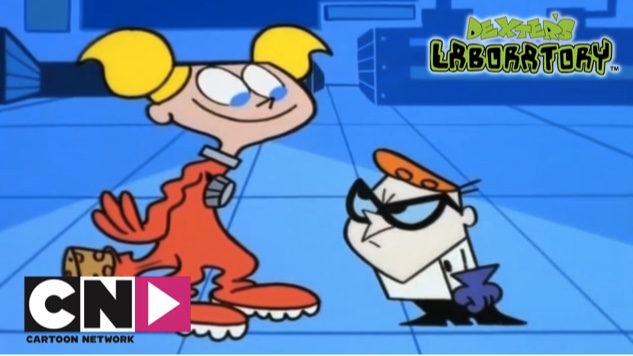
Creator: Genndy Tartakovsky
Stars: Christine Cavanaugh, Candi Milo, Allison Moore, Katherine Cressida, Kath Soucie, Jeff Bennett, Eddie Deezen, Rob Paulsen
Network: Cartoon Network
Dexter’s Laboratory is one of the crown jewels of Cartoon Network’s mid-’90s original series, created by visionary animator Genndy Tartakovsky, who would later go on to make the equally brilliant Samurai Jack. There was a freedom to this show, a sense that anything could and would happen in the boy genius/scientist’s realm, which is immediately implied by its classic, wordless opening sequence with its gothic, Danny Elfman-sounding music. Huge props also to Christine Cavanaugh, who provided the nasal, unexplainably accented voice of Dexter, which made him sound like a miniature, histrionic Peter Lorre. Her performance is a huge part of the show’s continued charm. —Jim Vorel
76. People of Earth (2016-2017)
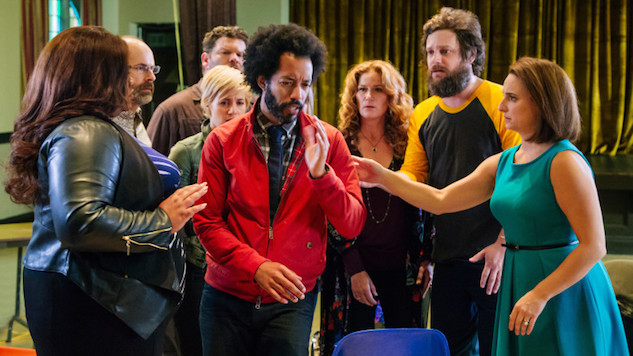
Creator: David Jenkins
Stars: Wyatt Cenac, Ana Gasteyer, Oscar Nuñez, Michael Cassidy, Alice Wetterlund, Luka Jones
Network: TBS
This high-concept comedy centers on a reporter (played by Daily Show alum Wyatt Cenac) who investigates a support group for people who believe they’ve been abducted by aliens. It’s an ensemble TV show in the vein of Community, featuring a colorful cast of characters tied together by a premise that never gets stale. But where the easy set up would see the series poke fun at these folks, it instead takes a turn for the heartfelt (with a good bit of poking fun, too, but still). And, unlike a lot of comedies on TV that think they’re smart, People of Earth actually is smart. Cenac has capably made the transition into leading man, and creator David Jenkins is almost certainly going to move on to something else great. —Trent Moore
75. The 100 (2014-)
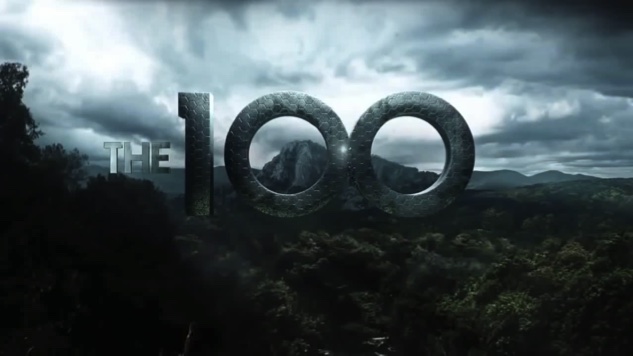
Creator: Jason Rothenberg
Stars: Eliza Taylor, Eli Goree, Thomas McDonell
Network: The CW
This post-apocalyptic sci-fi drama is set 97 years after a nuclear war wiped out almost all life on Earth. Survivors are living in a space station orbiting the Earth, hoping to one day return to their home. As resources on the ship become scarce and oxygen levels enter critical condition, the leadership decides to send 100 juvenile prisoners to Earth to see if the land is inhabitable. The “Lord of the Flies”-esque drama series follows these teens as they uncover surprises of what is left of mother earth. If you’re a thrill-lover, The 100 will keep you pressing “next episode.” —Jane Snyder
74. The Man in the High Castle (2015-)
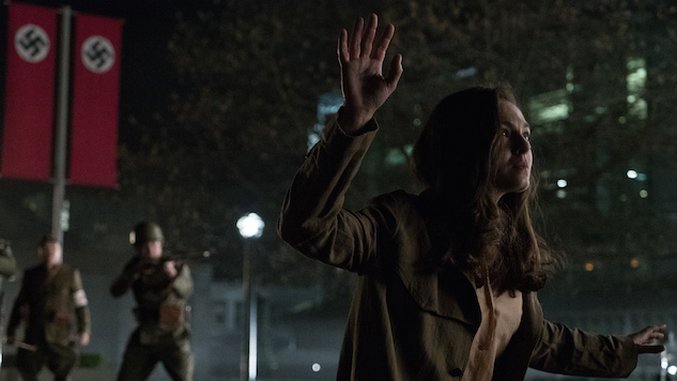
Creator: Frank Spotnitz
Stars: Alexa Davalos, Rupert Evans, Luke Kleintank, DJ Qualls, Joel de la Fuente, Cary-Hiroyuki Tagawa, Rufus Sewell, Brennan Brown, Callum Keith Rennie, Bella Heathcote
Network: Amazon
The Amazon original series, based on the 1962 novel by Philip K. Dick, could have landed on a number of other networks—or perhaps even in cinemas—at any other time. But the dystopian drama, set in an alternate history where the United States loses World War II, seems destined for now. the show depicts a not-so-United States in the years following World War II. Germany has taken over the Eastern states. Japan has the West Coast. In between is the neutral zone set along the Rocky Mountains. When Juliana Crain (Alexa Davalos), a woman in San Francisco, comes into possession of a newsreel-style film that depicts victory for the Allies, it sets her on a journey that will impact everyone around her. But the strangest thing about The Man in the High Castle is what happened in the U.S. less than six weeks before the second season’s premiere. Donald Trump won the presidential election. A stunned nation is now wrestling with “fake news” and “post-truth.” For anyone who woke up on Nov. 9, 2016, feeling as though they slipped into a parallel universe, the show took on new meaning. —Liz Ohanesian
73. Lost in Space (2018-)

Creator: Irwin Allen
Stars: Molly Parker, Toby Stephens, Maxwell Jenkins, Taylor Russell, Mina Sundwall, Ignacio Serricchio, Parker Posey
Network: Netflix
Lost in Space’s Molly Parker and Parker Posey generate much the same excitement as the series’ (many, mostly effective) action sequences. Its motor isn’t the force of the soldier, as represented by Toby Stephens’ gruff John Robinson, but the logic of the scientist (Parker), the guile of the con woman (Posey), the problem-solving acumen of Will (Maxwell Jenkins) and his older sisters, Penny (Mina Sundwall) and Judy (Taylor Russell). From using magnesium to melt ice and commandeering a “chariot”—a cross between a Jeep and a tank—to determining the cause of engine distress, the Robinsons are at their best untangling dilemmas, rather than blasting through them. At one point, facing a more complicated calculation than she expected, Maureen quips, “I’m gonna need a bigger whiteboard,” and it resounds as Lost in Space’s central proposition: That there’s room in the genre, and indeed on television, for the “science” in science fiction to be more than the expression of humankind’s worst instincts. In fact, though it’s been (not unreasonably) described as “darker” than Irwin Allen’s original, which aired on CBS from 1965 to 1968, the most important changes in Netflix’s remake—Parker’s top billing, Posey’s casting—reflect more depth than darkness, at least not darkness for its own sake. The series premiere aside, Maureen is John’s equal, if not, at times, the dominant figure in their relationship, one that turns out to be much thornier than it might seem. —Matt Brennan
72. Smallville (2001-2011)
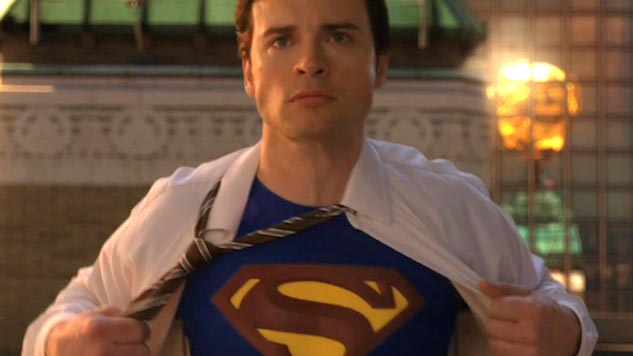
Creator: Alfred Gough, Miles Millar
Stars: Tom Welling, Kristin Kreuk, Michael Rosenbaum, Allison Mack, Sam Jones III, Erica Durance
Networks: The WB, The CW
So, 15 year-old Clark Kent is played by a 24 year-old man (Tom Welling) who doesn’t wear glasses and isn’t all that mild-mannered. Assuming he eventually becomes Superman, wouldn’t his high school friends all recognize him? With that as a premise/set-up, Smallville started off with both arms tied behind its back and still managed to make it 10 years as a (mostly) quality show. This is a hell of an achievement and only 36 non-daytime soap series have lasted longer. As a series set in high school (for the first four seasons), Smallville might have benefitted either by casting the lead younger or by skipping through high school at an accelerated rate. Still, Smallville managed to bring all the necessary high-school trimmings: first love, prom, rivalries with the jocks, spirit possession, mind-control and lots and lots of murder… you know, the usual. Season Four went off the rails when Clark became the school quarterback (seriously, did no one at The WB read a comic book?) but for most of the run, I was able to deal with the non-canon moments. That said, Smallville may be one of those shows that was “of its time” insofar as television programming (especially geek TV) has improved significantly over the last 5-10 years. It’s not that it wasn’t a good show, but I’d argue that 218 episodes was far too many to get where we all knew it was going, and it prolonged Superman’s Superboy period to an absurd length. —Mark Rabinowitz
71. Red Dwarf (1988-)
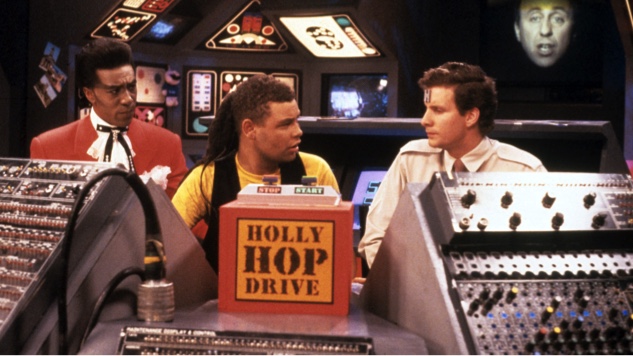
Creators: Rob Grant, Doug Naylor
Stars: Craig Charles, Chris Barrie, Danny John-Jules, Robert Llewellyn, Chloë Annett, Norman Lovett, Hattie Hayridge
Network: BBC Two
The British have a unique way of turning the end of the human race into a laugh. And like The Hitchhiker’s Guide to the Galaxy, Red Dwarf sees the human race reduced to a population of one with hilarious results. More of a riff on the Odd Couple than is typical of spaceship crews, Dave Lister wakes up three-million years after the rest of the Red Dwarf’s crew are killed by a radiation leak only to find himself alone in a titanic mining ship except for a hologram, a cat and a robot. Lister and his inhuman companions navigate too many twists and turns on their way back to Earth (or to get his girlfriend, whichever happens first) to recount here, but at least the working-class Liverpudlian gets his long-sought chicken vindaloo. The series lasted five years before its first hiatus, and has been revived three times since. —Ellie Decker & JD Jordan
70. The Rain (2018-)

Creators: Jannik Tai Mosholt, Esben Toft Jacobsen, Christian Potalivo
Stars: Alba August, Lucas Lynggaard Tønnesen, Mikkel Boe Følsgaard, Lukas Løkken, Jessica Dinnage, Sonny Lindberg, Angela Bundalovic, Lars Simonsen
Network: Netflix
If you’ve seen the one show about the telegenic young blonde who barely survives a near-apocalyptic event and now has to overcome her naïvety to fight off both the harsh post-catastrophe elements and humanity’s other remaining survivors in order to protect the last of her family AT ALL COSTS!!!, then you’ve seen The Rain, Netflix’s first Danish original series. This isn’t to say The Rain isn’t worth watching, necessarily; any viewer with the fortitude to overcome subtitles will enjoy, if nothing else, some really sharp cinematography and acting and just general atmospherics. Plus, watching this story play out in a non-North American, non-English speaking country is engaging for its novelty. The emotional arc of the story, too, for all it is a mashup of the seven thousand YA-adjacent dystopian/post-apocalyptic/survival thriller shows and films that have come before it, isn’t bad. After what is essentially an anxiety-fueled bottle episode weirdly positioned as the pilot, the two main characters encounter the rest of the season’s principals in a dire, gripping way, and the circumstances that force the lot of them both into cahoots and into taking the particular trip that they do make enough sense to keep you interested—especially as each subsequent episode turns its lens to a new secondary character to follow back in time to when the apocalyptic implications of the viral rain were still making themselves known, and that character was just becoming the hardened person they are in the present. All of this, remarkably watchable. —Alexis Gunderson
69. ALF (1986-1990)

Creators: Paul Fusco, Tom Patchett
Stars: Paul Fusco, Max Wright, Anne Schedeen, Andrea Elson, Benji Gregory
Network: NBC
Somehow, like Full House, this series also featured a family named “The Tanners,” but that’s where the comparisons end. A bizarre show in retrospect that featured a puppet as the titular character, ALF was about an alien named “Gordon Shumway” who crash-lands in the backyard of a suburban family and then proceeds to work his way into their hearts while waiting for his cohorts to stop by and pick him up, occasionally attempting to catch and eat the family cat along the way. Most episodes play out as a cross between Perfect Strangers and Growing Pains, as ALF learns about various human customs and the family attempts to shield him from the public and the government officials hunting for him. It all builds to one of the most insane TV finales of all time, as Gordon is captured by the government and brought to a lab, with the implication that he will be dissected alive in the name of science. Seriously, that’s how ALF ended. It was meant to be a cliffhanger ending, but because a fifth season of ALF was never produced, one of the weirdest sitcoms of the decade ended in one of the weirdest ways. —Jim Vorel
68. 3% (2016-)

Creators: Pedro Aguilera
Stars: Bianca Comparato, João Miguel, Michel Gomes, Rodolfo Valente
Network: Netflix
U.S. shows have long been a part of Netflix’s offering in foreign countries, and the streaming service has brought a handful of foreign TV shows to America. But 3% is Netflix’s first original Brazilian production. Set in a dystopian future where only 3% of the population is chosen to live in a Utopian society, while the rest of humanity struggles in destitution, the show follows a group of 20-year-old candidates competing to be among the chosen, some of whom may be part of a revolutionary group called The Cause. Part pyschological thriller, part sci-fi morality play, the eight-episode series is full of characters on both sides of the test, struggling to win a chance at a better life without abandoning their principles. —Josh Jackson
67. Continuum (2012-2015)

Creator: Simon Barry
Stars: Rachel Nichols, Victor Webster, Erik Knudsen, Stephen Lobo, Roger Cross
Network: Showcase
I’m starting to grow suspicious: Do Canadians plug into the walls at night? Orphan Black has made its mark in the U.S. (with Tatiany Maslany finally winning an Emmy), but it’s far from the first noteworthy Canadian sci-fi import. Continuum rises above both the usual fare we find on Syfy and on network television. The show follows the efforts of Kiera Cameron (Rachel Nichols) to thwart the ambitious and destructive terrorist group Liber8. The hook: Cameron and the terrorists are accidental transplants from the year 2077, where corporations subsidized global debt with the subordination of the world’s governments. The collision is not about the obliteration of one perspective, but the slow formation of compromised strengths. The political disconnect encourages us to remain impartial. The show’s character development can come in waves, but Nichols remains capable of carrying whatever material she’s handed to evocative, substantial places. Plus: She takes down do-badders towering over her like ogres more convincingly than any other actress on television. —Kyle Burton
66. Lexx (1997-2002)

Creator: Paul Donovan, Lex Gigeroff, Jeffrey Hirschfield
Stars: Brian Downey, Eva Habermann, Michael McManus, Xenia Seeberg, Jeffrey Hirschfield, Tom Gallant
Network: Global TV, Sci Fi
The crew of Lexx (a plant-ship shaped like a dragonfly that can blow up worlds) is a motley one: a human courier, an emotionless undead assassin, a renegade love slave and a robot head that thinks it’s a love slave. If you think George R.R. Martin’s spins a high body count, check out Lexx. Aside from being oddly sex-charged for a B-grade space opera, Lexx sees the population of two whole universes wiped out (including our Earth), all while half the crew of this insect-shaped ship are on-again-off-again trying to kill (or eat) the other half. And they’re not even all alive to start with! After premiering on CityTV in Canada, the show was eventually picked by by the Sci-Fi Channel, where it ran for four absolutely bizarre seasons. —Ellie Decker & JD Jordan
65. Max Headroom (1987-88)
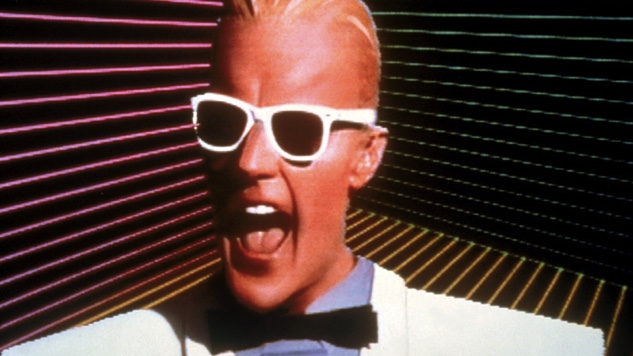
Creator: Annabel Jankel, Rocky Morton, George Stone
Stars: Matt Frewer, Amanda Pays, Chris Young, W. Morgan Sheppard, Charles Rocket, Jeffrey Tambor
Network: ABC
One of the most indelible images of the ’80s was that of Max Headroom, a glitchy, computer-generated spokesperson/TV host with stuttering speech patterns. Throughout the decade, the character (played by actor Matt Frewer, stuck in a foam and Plexiglas costume) seemed to get reinvented every couple of years from TV movies in the UK to pimping New Coke here in the States. For a short stretch in the late ’80s, though, Headroom was the titular character in a dystopic series that ran briefly on ABC. Built off the same presence as the UK film, the show depicted a future that doesn’t seem that impossible today, a world is ruled by TV networks that use their technology to track the actions and thoughts of viewers. When an investigative reporter (Frewer) uncovers a scandal and is injured trying to escape with the information, a hacker uploads his mind into a computer and Max Headroom is born. The online figure helps his fellow reporters dig into the nasty work their employer Network 23 is up to. It’s a preposterous premise but the show has proven to be strangely prescient some 30 years after its premiere, and its dark undercurrent paved the way for other series like Twin Peaks and Dark Angel. —Robert Ham
64. Helix (2014-2015)
Creator: Cameron Porsandeh
Stars: Billy Campbell, Hiroyuki Sanada, Kyra Zagorsky, Mark Ghanimé, Matt Long
Network:
Helix is a claustrophobic quarantine thriller that begins with a throwback virus running wild in a Greenland research station. The show takes a couple of episodes to generate the momentum needed to override its missteps. Two days into its outbreak, Helix just about keeps ahead of its logical inconsistencies and muted performances by ratcheting up the horror quotient. The most intriguing aspect of the series may actually be the contagion itself, a kind of “contained rage” virus that promises an intelligent (and equally malevolent) version of the enemies found in The Walking Dead or 28 Days Later. The show skips any initial mystery about who’s behind the infection, with the lead villain—Hiro, the head of the Arctic Biosystems lab—identified in the opening scene. Hiro comes across one of his scientists, Peter, in the grotesque throes of the disease, which he coolly calls “Progress.” As the show progresses, it delves deeper into paranoia, hallucination and self-mutilation. If you like your sci-fi with a slice of madness and horror, Helix may be for you. —Andrew Westney
63. Astro Boy (1980, 2003)
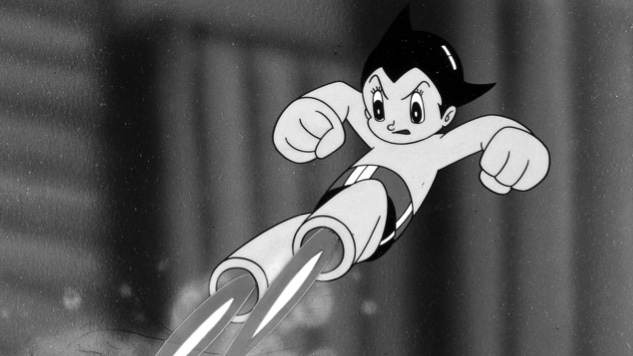
Creators: Osamu Tezeku, Noboru Ishiguro
Stars: Billie Lou Watt, Esperanzita Martinez, Mari Shimizu, Ray Owens
Network: Nippon TV, ABC
Negligent and absent fathers are universal across all forms of anime, though especially in the “shonen” genre of action-adventure and martial arts-focused series. Of all the most disreputable and horrendous dads worthy of condemnation in anime, Dr. Tenma ranks among the worst by dint of his seniority. A legendary scientist and pioneer of robotics engineering, Tenma is the creator and “father” of Atom, or “Astro,” the titular protagonist of Osamu Tezuka’s landmark 1980 manga and anime series of the same name. In the depths of his despair following the death of his son Tobio in a car collision, Tenma pours the sum total of his grief and genius into resurrecting him in the form of a robot, Atom, who he then adopts and raises as his own. However, after several seemingly happy years living together, Tenma becomes despondent—sullen and resentful that no matter how advanced his intelligence and empathy, the boy robot could never grow or age like a real child, thus making a painful reminder of Tenma’s own inability to fill the void of his son’s death. Of no fault of his own, Astro is abandoned by his father and sold to a robot circus, where he is then later adopted by the kindly Professor Ochanomizu and given a true home. Astro would later confront his crazed father and fight against his army of malicious robots, besting them time and again before eventually convincing Tenma to repent and renounce his evil ways. Tenma’s actions serves as not only the catalyst to Astro’s growth as a sentient being, but the spark to his maturation into true hero. —Toussaint Egan
62. Warehouse 13 (2009-2014)
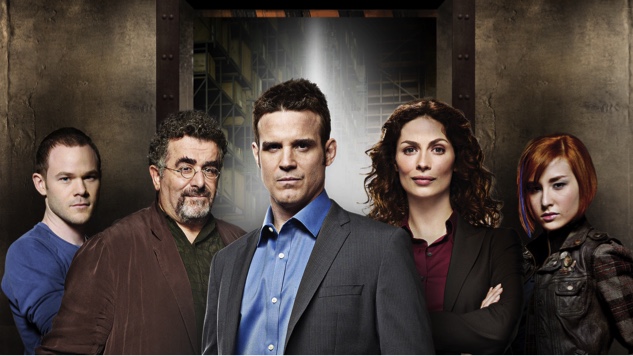
Creators: Jane Espenson, D. Brent Mote
Stars: Eddie McClintock, Joanne Kelly, Saul Rubinek, Genelle Williams, Simon Reynolds, Allison Scagliotti, Aaron Ashmore
Network: SyFy
SciFi rebranded to SyFy in early 2009, with the aim of being more inclusive of all parts of the genre television spectrum. Cue that July’s premiere of Warehouse 13, the South Dakota-based sister series to Eureka which focused on a tiny team of irrepressibly quirky federal agents whose job it was to track down supernaturally empowered historical artifacts to store safely away from humanity in a remote and extremely top-secret storage facility. Death and destruction and the total annihilation of the known timestream and/or universe were always on the table—and major characters did die—but, like with Eureka before it, Warehouse 13 was far more interested in the jokes and sight gags and arrestingly odd interpersonal shenanigans its endlessly game cast could always be depended on to deliver. That cast, which originally included Joanne Kelly and Eddie McClintock as classic odd couple co-lead Agents Myka Bering and Pete Lattimer, Saul Rubinek as grumpy Warehouse guardian Artie Nielsen, Allison Scagliotti as punk teen hacker Claudia Donovan, and Genelle Williams as aura-reader Leena, added two bold doses of LGBTQ representation in later seasons with Aaron Ashmore as Claudia’s new partner, the proudly out human lie detector, Steve Jinks, and Jaime Murray as Myka’s new romantic foil, the proudly bisexual, proudly chaotic neutral classic science fiction writer, lady H.G. Wells. Every part of this show was over the top and ridiculous—Lewis Carroll’s mirror, Mata Hari’s stockings, and Lizzie Borden’s compact all played pivotal roles in early seasons, while the marquee from 42nd Street from the Mark Strand Theater trapped the whole main cast in an endless tap dancing routine in the series finale (see above)—and the wild twists of artifact magic were executed, generally, with bluntly obvious CGI effects, but that was what made Warehouse 13 so fun, and such a great legacy for the all-inclusive SyFy rebranding. —Alexis Gunderson
61. Misfits (2009-2013)
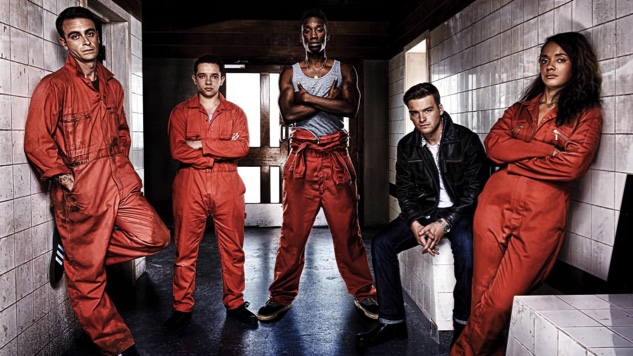
Creator: Howard Overman
Stars: Iwan Rheon, Robert Sheehan, Lauren Socha, Nathan Stewart-Jarrett, Antonia Thomas, Joseph Gilgun, Karla Crome, Nathan McMullen, Natasha O’Keeffe, Matt Stokoe
Network: E4
The plot: A handful of juvenile delinquents experience a strange universal shift during an electrical storm that causes each of them to gain various super powers. Thus, they become “superhoodies.” On the surface, it seemed like the plot of a science fiction show and that’s not incorrect. The early episodes of Misfits were some of the most underrated and low-key, sci-fi episodes on television—it was sci-fi for people who weren’t sure they liked sci-fi. Admittedly, Misfits often doesn’t get a fair shake, thanks to the cast turnover and lack of satisfying story follow-through in later seasons. That said, the one thing Misfits got exceedingly right was their look at the lives of working class, high school-aged kids who are often shrugged off or labeled “trouble.” While you’d never see the likes of Simon (Iwan Rheon, currently crushing it on Vicious alongside Ian McKellen), Kelly (Lauren Socha) or Nathan (Robert Sheehan) sitting in a history class, viewers still witnessed their struggle with every day teenage life. The closest you’d find to a stereotypical goody two shoes on Misfits was Simon. Rheon’s portrayal of the shy and often overlooked Simon was one of the most captivating parts of the show. When Simon, faced with Alisha’s super sexual appeal, would mutter his darkest fantasies, you saw a completely different, but very real side of the average boy. The things that came out of his mouth could only come from a porn-obsessed teen. His foil came in the form of Nathan, a goofy, loud-mouthed jokester who seemed to think his greatest gift was his ability to have a smart answer for absolutely any topic… that is until he discovered his super power. The superhoodies of Misfits were without a doubt to sort of kids you’d roll your eyes at on the street. Yet, creator Howard Overman (Atlantis, Dirk Gently) turned the miscreants into humans who, though they were flawed, were absolutely worth rooting for. —Deirdre Kaye
60. Invader Zim (2001-2002)
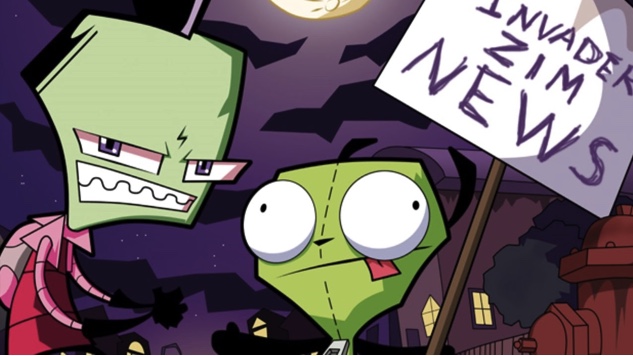
Creator: Jhonen Vasquez
Stars: Richard Steven Horvitz, Andy Berman, Rosearik Rikki Simons, Melissa Fahn, Rodger Bumpass, Lucille Bliss, Wally Wingert, Kevin McDonald
Network: Nickelodeon
At a time when original Nickelodeon cartoons included Rocket Power and The Fairly Oddparents, Invader Zim was the network’s attempt to attract the slightly older Cartoon Network crowd. They wanted something edgy and a little bizarre. They got it tenfold with Jhonen Vasquez, a comic-book writer and cartoonist whose previous projects included the hyper-violent comic series Johnny: The Homicidal Maniac, Squee and I Feel Sick. His concept for Nickelodeon was simple: Invader Zim was the story of naive but psychotic Zim, the smallest member of an alien species in which social hierarchy is determined by height, who is assigned to conquer an insignificant planet on the outskirts of the universe: Earth. Although dispatched simply to collect undercover surveillance and stay out of the way, Zim—along with his malfunctioning erratic robot drone, GIR—decides to conquer our planet himself. However, all his attempts to take over are either thwarted by his own inexperience or by Dib, a young paranormal investigator who realizes Zim is an alien. This backstory is quickly summed up in the packed intro, which shows Zim traveling to Earth, setting up his house and literally consuming the planet under the might of his machines—if only in his dreams. We also see the strange and fantastical spaceships and technology that creator Jhonen invented for his world, along with a hint at the show’s humor and art style—all of which help demonstrate what made Invader Zim the cult cartoon hit it still is today. —James Charisma
59. Colony (2016-2018)
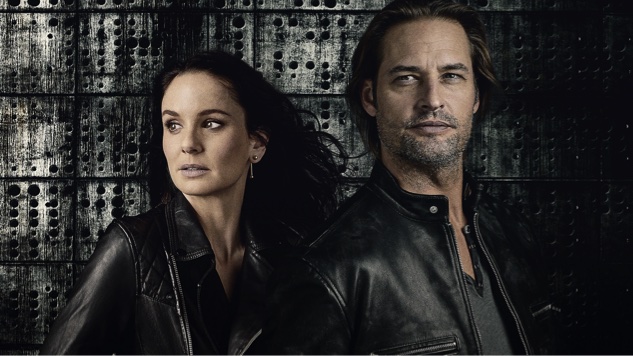
Creators: Carlton Cuse, Ryan J. Condal
Stars: Josh Holloway, Sarah Wayne Callies, Peter Jacobson, Amanda Righetti, Tory Kittles
Network: USA
Josh Holloway. Need I say more? Okay, fine. Holloway stars as former FBI agent Will Bowman. He and his wife Katie (Sarah Wayne Callies of The Walking Dead) live in Los Angeles, where aliens have invaded and now occupy the city. Nothing can be done without their knowledge. Will and Katie were separated from their son at the time of the invasion and now must decide what lengths they are willing to go to in order to get him back. From executive producers Carlton Cuse (Lost) and Ryan Condal, the series plays on the tension between protecting your family and rising up against oppressive invaders and what happens when husband and wife find themselves on different sides of that line. —Shannon M. Houston
58. Killjoys (2015-)
Creator: Michelle Lovretta
Stars: Hannah John-Kamen, Aaron Ashmore, Luke Macfarlane
Network: Syfy
This Canadian co-production debuted with minimal fanfare two seasons ago, and turned out to fill the hole left behind by Joss Whedon’s dearly departed Firefly. As the series heads into its third season this summer, it promises even more space bounty hunter action, all wrapped up in a world on the verge of all-out war. Even better, it features breakout star Hannah John-Kamen, who was over the big screen this year in Tomb Raider, Ready Player One and Ant-Man and the Wasp. —Trent Moore
57. Better Off Ted (2009-2010)
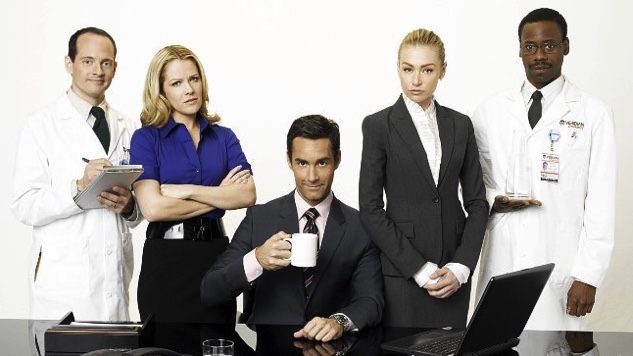
Creator: Victor Fresco
Stars: Jay Harrington, Portia de Rossi, Andrea Anders, Jonathan Slavin, Malcolm Barrett, Isabella Acres
Network: ABC
This ABC satire starred Jay Harrington as Ted Crisp, the head of research and development at a soulless conglomerate where nothing is too far-fetched. In between creating suicidal turkeys and freezing co-workers, he often had to compromise his own ethics with that of his employer Veridian Dynamics. The show often broke the fourth wall making the audience more active participants; however, the show never caught on. ABC shocked everyone by renewing Better Off Ted for a second season, before canceling it after just 26 episodes. —Shaina Pearlman
56. Star Trek: Voyager (1995-2001)
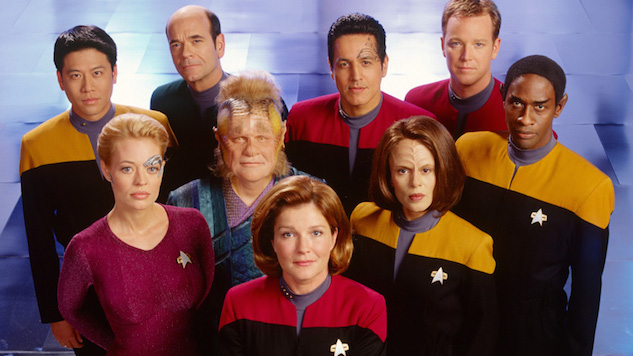
Creators: Rick Berman, Michael Piller, Jeri Taylor
Stars: Kate Mulgrew, Robert Beltran, Roxann Dawson, Jennifer Lien, Robert Duncan McNeill, Ethan Phillips, Robert Picardo, Tim Russ, Garrett Wang, Jeri Ryan
Network: UPN
If the original Enterprise explored strange new worlds, sought out new life and new civilizations and boldly went where no man had gone before, Voyager showed what a woman could do. The unflappable Captain Kathryn Janeway (Kate Mulgrew) guided her crew home when an energy wave transported them across the Milky Way into the Delta Quadrant, home to plenty of new civilizations and dominated by Star Trek’s best adversary of all time, the Borg. Where the first two series were about exploration by a Utopian society and Deep Space Nine was a more honest look at the difficulties of simple co-existence, Voyager was all about the journey home. The crew, made up of Starfleet and Maquis rebels, were brought together out of necessity but had to rely on each other in part of the galaxy that was strange even to professional explorers of space. In addition to the usual human/Vulcan/Klingon characters, the ship was home to a local Talaxian guide, a holographic doctor who developed self-awareness, and a Borg drone separate from her hive and re-learning her humanity. With only each other to rely on, Voyager was the most interpersonal series in the Star Trek universe. —Josh Jackson
55. Caprica (2010)

Creator: Remi Aubuchon, Ronald D. Moore
Stars: Eric Stoltz, Esai Morales, Paula Malcomson, Alessandra Torresani, Magda Apanowicz, Sasha Roiz, Brian Markinson, Polly Walker
Network: SyFy
Few shows on this list were as highly anticipated as this Battlestar Galactica prequel. With a fascinating and timely premise, examining how a world much like ours quickly succumbed to the temptations of rapid technological advancement, and the most compelling sci-fi show to build from, how could anything go wrong? Driven by grief and a desire to bring back a lost daughter, wealthy technocrat Daniel Graystone (Eric Stoltz) creates a virtual intelligence that will eventually lead to the apocalypse of the Cylon attacks. Unlike Battlestar’s grim struggle for survival of the species, Caprica shows us a world high on its own achievements and a hidden alternate virtual reality where any desire can be fulfilled. But the series never found its expected audience and SyFy axed it after a single season. —Josh Jackson
54. The Middleman (2008)
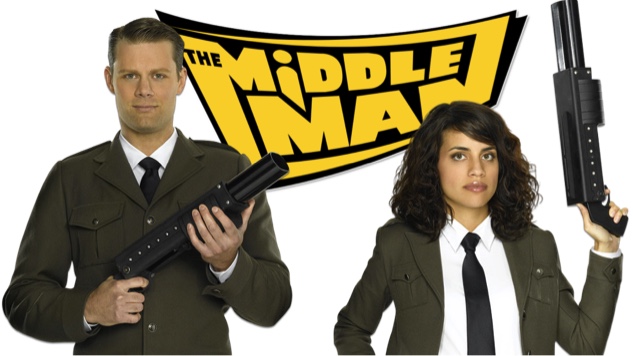
Creator: George Lucas
Stars: Matt Keeslar, Natalie Morales, Mary Pat Gleason, Brit Morgan, Jake Smollett
Network: ABC Family
Although ABC Family is now mostly known for self-involved teens and their petty problems, in 2008 the network forayed into a new genre when it joined forces with Javier Grillo-Marxuach to bring his comic-book series to the small screen. Starring Natalie Morales (of Parks & Recreation, not the NBC reporter) and Matt Keesler (Scream 3), the pop-culture-reference-infused show followed Wendy Watson (Morales) and the Middleman (Keesler) as they protected the world against villains big and small, human and alien. The show was canceled after 12 episodes, but was given a proper finale in the comic, The Middleman: The Doomsday Armageddon Apocalypse. —Shaina Pearlman
53. Eureka (2006-2012)
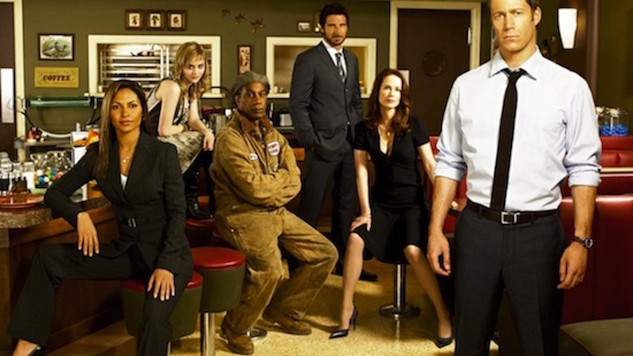
Creator: Andrew Cosby, Jaime Paglia
Stars: Colin Ferguson, Salli Richardson-Whitfield, Joe Morton, Debrah Farentino, Jordan Hinson, Ed Quinn, Erica Cerra
Network: Syfy
Set in the quirky, scientist-saturated, totally top-secret Pacific Northwestern town of the same name, Eureka was then-SciFi’s big swing of a counterargument to the gritty seriousness of Battelstar Galactica, which had premiered two years earlier and launched SciFi into the pop culture mainstream. Where Battlestar Galactica was all grays and blacks and cramped metal hallways, Eureka was open sky and lush PNW forests and a cheerful whistling theme song; where Battlestar’s resident geniuses colluded with genocidal humanesque clones, Eureka’s lot over at Global Dynamics tinkered with technological goo and android dogs and pheromonal peptides that cause love stampedes; where Battlestar’s uniformed officers strategized space war against those same genocidal humanesque clones, Eureka’s solitary two—eternally gobsmacked outsider Sheriff Jack Carter (Colin Ferguson) and eternally exasperated insider Deputy Sheriff Jo Lupo (Erica Cerra)—used their practical training and relatively astronomical EQ to save the town’s various head-in-the-clouds quantum physicists from the comedic excesses of their own geniuses. This is not to say that Eureka didn’t deal with complex, dark-ish arcs—long before he was the scheming Papa Pope, Joe Morton nearly set Eureka on fire with Dr. Henry Deacon’s grief at losing his wife—but those more serious stories were always offset with Jack’s banter with his Smart House, or Jo’s flirtatiously combative slapstick with bad boy scientist Zane Donovan (Niall Matter), or bumbling super-genius Fargo (Neil Grayston) doing just about anything—including guest starring on sister goofball series, Warehouse 13. The more serious stories were fine, but it was those effortlessly light, entirely un-self-serious touches that made Eureka’s short five seasons such refreshing fun to watch. —Alexis Gunderson
52. Pinky and the Brain (1995-1998)
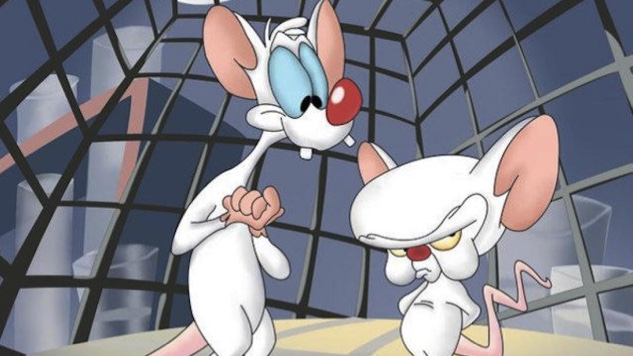
Creator: Tom Ruegger
Stars:: Maurice LaMarche, Rob Paulsen
Network: Kids’ WB
America’s favorite genetically altered lab mice first appeared in 1993 on the brilliant Warner Bros. sketch show Animaniacs. The Brain’s myriad plans for world domination are hatched from the dungeon-like Acme Labs with the help of his much more jovial assistant Pinky. The megalomaniac Brain, a cross between Orson Welles and Vincent Price, has no ill will towards humanity; he’s just certain that he’s the best equipped to rule the world. Sadly, his schemes never go exactly as planned. Being ruled by a benign, highly intelligent lab rat doesn’t sound quite as bad as it used to. —Josh Jackson
51. Supergirl (2015-)
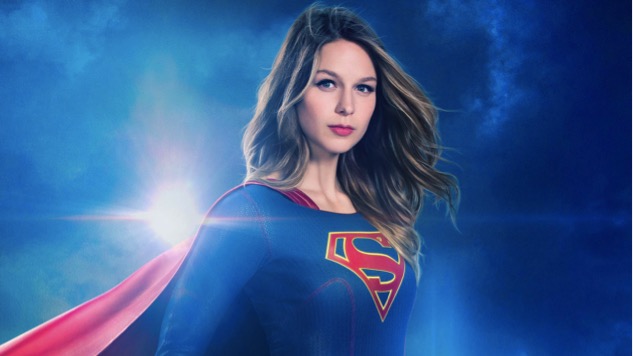
Creators: Greg Berlanti, Ali Adler, Andrew Kreisberg
Stars:: Melissa Benoist, Mehcad Brooks, Chyler Leigh, Calista Flockhart, Jeremy Jordan, David Harewood, Chris Wood, Floriana Lima
Networks: CBS, The CW
Not since Lynda Carter began deflecting bullets with her bracelets has there been such a high-profile debut of a female superhero on network television. The fact that it only lasted a season on CBS before getting shuffled to the CW can’t be pinned on superb lead Melissa Benoist as the titular cousin to the Man of Steel. The series was a bigger hit with critics than audiences, celebrating the feminine strength and innate goodness of its source character in stark contrast to Zach Snyder’s darker vision of Krypton’s most famous son. Kara Zor-El confronts both the responsibilities of her inhuman powers and the difficulties of working for callous media exec Cat Grant (Calista Flockhart), while juggling friendships, romances and family dysfunction of world-ending proportions. That this fun, family-friendly action adventure couldn’t make it on CBS says more about network television than anything else. Thankfully Supergirl found a new place to save National City. —Josh Jackson
50. Timeless (2016-)

Creators: Eric Kripke, Shawn Ryan
Stars: Abigail Spencer, Matt Lanter, Malcolm Barrett, Paterson Joseph, Sakina Jaffrey, Claudia Doumit, Goran Višnji?
Network: NBC
NBC’s Timeless treats history and historic underdogs and the dangers of weaponized technological advancement with more respect and quietly radical, inclusive humanity than just about any other time-travel show out there. The compassion and intellectual rigor with which Lucy (Abigail Spencer), Wyatt (Matt Lanter), Rufus (Malcolm Barrett), Jiya (Claudia Doumit), Agent Christopher (Sakina Jaffrey), Conor (Paterson Joseph) and even, occasionally, laser-focused former-enemy Flynn (Goran Visnjic) face the moral knottiness of infiltrating past timelines—and their utter commitment to progress and reparative equity and individual humility—is a weekly master class in how to keep getting better at being human. Season Two’s two-part finale, featuring one timeline in which the team supported a badass Harriet Tubman (Christine Horn) and one in which the lives of multiple of their own team members were the core plot points but Lucy used her walk-and-talk to underscore the shameful truth of San Francisco’s oppression of its Chinese residents in the 1880s rather than rehash their personal problems, is a perfect example of this, but so was the previous episode which saw Reagan’s attempted assassination serve as the fulcrum for a focus on the importance of Agent Christopher’s wife and kids, and the thunderous changes honesty about one’s identity make across time, and so was the one before that, which saw women’s suffrage nearly snuffed out. And so on, and so on. —Alexis Gunderson
49. Mork & Mindy (1978-1982)
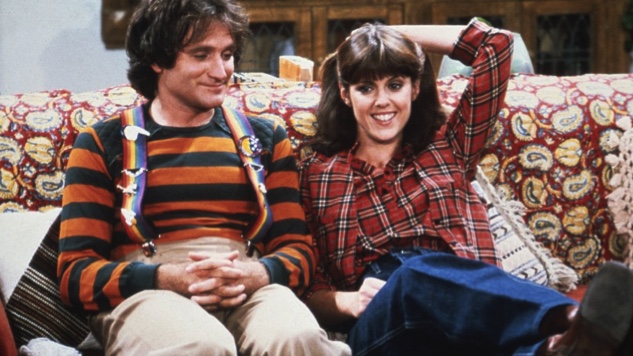
Creator: Garry Marshall, Dael McRaven, Joe Glauberg
Stars: Robin Williams, Pam Dawber, Jay Thomas, Gina Hecht, Jonathan Winters
Network: ABC
The world was introduced to Robin Williams playing the Mork from the planet Ork on an episode of Happy Days. His talent was so apparent that ABC gave him his own show. His comedy was already alien, and the mile-a-minute slapstick of that first season felt completely original. Things went largely downhill from there with the introduction of Jonathan Winters as Mork and Mindy’s “baby” in Season 4, but even bad Mork & Mindy was better than most sitcoms of its era. —Josh Jackson
48. The Outer Limits (1963-1965)
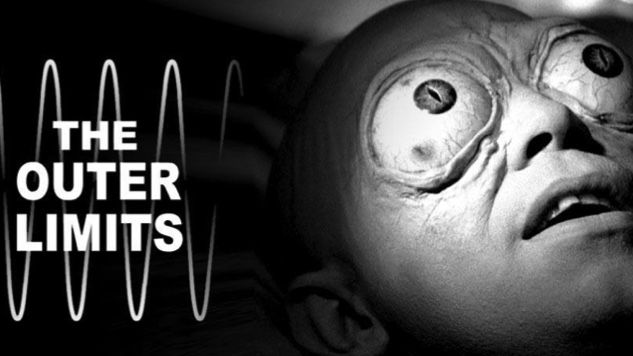
Creator: Leslie Stevens
Stars: László Benedek, Abner Biberman, John Brahm, John Erman
Network: ABC
In the realm of influential, early anthology shows, The Outer Limits is probably forever cursed to play second fiddle to the likes of The Twilight Zone. Yet, while the program’s 49 episodes may not always have the consistency or emotional wallop of Rod Serling’s masterpiece, its stories embraced an arguably more complex, morally relative worldview, whether that week’s installment was a monster-centric horror yarn or a Harlan Ellison-penned “hard” sci-fi joint. What’s more impressive is how, over half-a-century after the fact, some of the show’s super-cheap creature designs remain eerily unnerving, as evidenced by the human-faced insectoids at the center of “The Zanti Misfits” (don’t Google it, it will give you nightmares). On the larger scale, it’s fascinating to note how the show may have planted the ideas for future seminal works, whether it be “The Architects of Fear” for Alan Moore and Dave Gibbons’ Watchmen or “Demon with a Glass Hand” for The Terminator franchise (though James Cameron will legally dispute that). Each week, the opening title sequences promised that we were “about to participate in a great adventure.” More often than not, The Outer Limits kept this promise. —Mark Rozeman
47. Star Wars: The Clone Wars (2008-)

Creator: George Lucas
Stars: Matt Lanter, Ashley Eckstein, James Arnold Taylor, Dee Bradley Baker, Tom Kane
Network: Cartoon Network/Netflix
Contrary to popular belief, Lucasfilm did manage to create an engaging storyline set in the “prequel” universe. Enter Star Wars: The Clone Wars. Acting as a bridge between Attack of the Clones and Revenge of the Sith, the show finds Anakin Skywalker and Obi-Wan Kenobi, along with new character Ahsoka Tano, battling against the forces of Dooku and General Grievous. What started as a series full of fun, exciting space battles, however, soon grew into a much deeper and richer story that explored the complications and brutality of war. Moreover, The Clone Wars did more to set the stage for Anakin’s inevitable turn to the Dark Side than any moment in the films. While the show’s brand of photo-realistic animation may not be for everyone, there are few who will deny that the sophisticated storytelling on display would not have been greatly welcome in the traditional Star Wars movie universe. —Mark Rozeman
46. Counterpart (2017-)

Creator: Justin Marks
Stars:: J. K. Simmons, Olivia Williams, Harry Lloyd, Nazanin Boniadi, Sara Serraiocco, Ulrich Thomsen, Nicholas Pinnock
Network: Starz
Creator Justin Marks’ espionage drama sucks you in with a gimmick—Why have one J.K. Simmons on screen when you can have two? Especially when his characters bicker much of the time because one is considerably more Alpha?—but amidst all its Cold War-meets-science fiction complexities, Counterpart has much more to offer than a story about rogue agents from an alternate universe who are sent here to kill us. Thanks in no small part to characters like Nazanin Boniadi’s Clare, the show offers a richly detailed and thought-out take on revisionist histories, terrorism by those who do not see themselves as terrorists, governmental cover-ups and even whether we can really know our own spouses. —Whitney Friedlander
45. Altered Carbon (2018-)
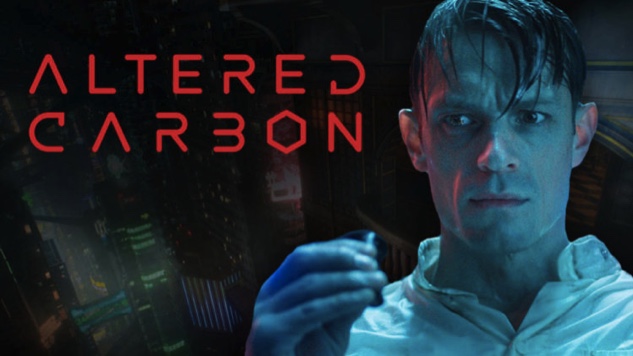
Creator: Laeta Kalogridis
Stars:: Joel Kinnaman, James Purefoy, Martha Higareda, Chris Conner, Dichen Lachman, Ato Essandoh
Network: Netflix
Netflix’s recent sci-fi series Altered Carbon rivals HBO’s Westworld in terms of both beautifully constructed future worlds and naked bodies that are essentially ciphers, devoid of human soul. The cyberpunk noir show follows a resistance fighter revived into a new body, or “sleeve,” centuries after his revolution has failed. To win his freedom he must solve a murder mystery for one of the super-elite ancient Meths (short for that Biblical old-timer Methuselah), who buy new cloned bodies to house their back-up personalities, housed in a data core at the base of the brain stem. The technology, which allows for resurrection of the dead and instant travel across star systems, raises questions about religion, justice and familial relationships, like when agnostic police detective Kristin Ortega brings her grandmother home in the body of a pierced, tattooed convict to celebrate All Hallows Eve—her neo-Catholic family believes a soul brought back from the dead can never rest. It’s hard sci-fi without much of a sense of humor, but the acting (Joel Kinnaman, James Purefoy, Renée Elise Goldberry), directing (Game of Thrones’ Miguel Sapochnik handles the pilot) and visual effects give the genre a claim to prestige television, and the hardboiled drama and blockbuster-worthy fight scenes have so far kept me coming back for more. —Josh Jackson
44. Dark Matter (2015-2017)

Creators: Joseph Mallozzi, Paul Mullie
Stars:: Melissa O’Neil, Anthony Lemke, Alex Mallari Jr., Jodelle Ferland, Roger Cross, Zoie Palmer, Marc Bendavid
Network: Syfy, Space
Based on the Dark Horse Comics series of the same name, Dark Matter kicks off as six people wake up on a spaceship with no memories of who they are or how they ended up there. What follows are three seasons of adventures that gradually ratchet up the stakes while still focusing on glorious character development. Because when you don’t know whether you’re a hero or a villain, you have to redefine your identity. Dark Matter also boasts three kickass female protagonists, including one of the most endearing Androids on television. So it was disheartening when Syfy recently made the shortsighted decision to cancel the show. We need more three-dimensional leading ladies interacting on our screens, and Dark Matter has them in spades. Luckily, you can still binge every season on Netflix. —Frannie Jackson
43. The Jetsons (1962-1963)
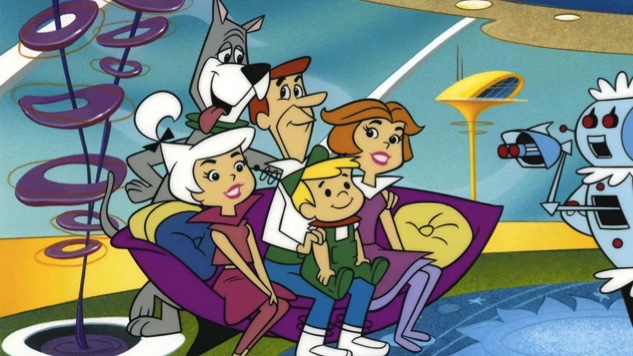
Creators: William Hanna, Joseph Barbera
Stars:: George O’Hanlon, Penny Singleton, Janet Waldo, Daws Butler, Mel Blanc, Don Messick, Jean Vander Pyl, Howard Morris
Network:: ABC
Meet George Jetson! Zipping through the clouds of Orbit City in his flying saucer, he’s off to work in the morning with his family. He drops off his son, Elroy, at elementary school, his teenage daughter, Judy, at high school, and his wife, Jane, at the mall. He arrives on a moving sidewalk for his job at a sprocket company, where he simply has to press buttons. This is the future of The Jetsons, the Space Age equivalent of The Flintstones, where everyone lives in elevated Space Needle-type platforms high above the Earth and technology isn’t just commonplace, it’s a way of life. As with The Flintstones, the setting is less the subject of social commentary than a backdrop for the show’s sitcom format and an excuse for period-themed jokes and gags. Much of the technology we use regularly today didn’t exist when The Jetsons was produced, including cell phones, personal computers and the Internet. But in today’s world, where everyone’s got their nose in a laptop or iPhone, it’s nice not to see everyone in The Jetsons’ version of the future doing the same. For all the perks of the 21st century, we might still have some growing up to do. —James Charisma
42. Sense8 (2015-2018)
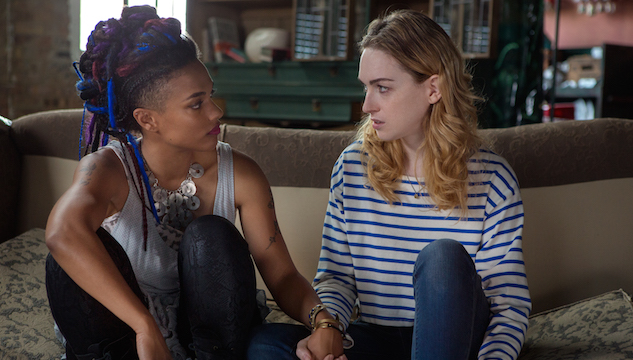
Creators: The Wachowskis, J. Michael Straczynski
Stars: Tuppence Middleton, Brian J. Smith, Doona Bae, Aml Ameen, Max Riemelt, Tina Desai, Miguel Ángel Silvestre, Jamie Clayton, Freema Agyeman, Terrence Mann, Anupam Kher, Naveen Andrews, Daryl Hannah
Network: Netflix
There was no bigger WTF TV show in the world than Sense8. This globe-trotting and glitzy sci-fi series, created by Lana and Lilly Wachowski (co-directors of The Matrix trilogy) and former Babylon 5 showrunner J. Michael Straczynski, drops us into a world where eight strangers in different parts of the planet are somehow psychically and emotionally linked. Through the first season’s 12 episodes—and the recent Christmas special follow this assortment of confused and beautiful people as they try to understand this connection, use their newfound abilities to help one another, and engage in not one but two blissfully queer orgies. As wacky and over-the-top as Sense8 can often get, the series remains important as it deals with issues of sexuality and gender identity through the work of trans actress Jamie Clayton and performers Miguel Silvestre and Alfonso Herrera’s portrayal of a gay couple in Mexico City. —Robert Ham
41. 12 Monkeys (2015-2018)
Creator: Terry Matalas and Travis Fickett
Stars: Aaron Stanford, Amanda Schull, Kirk Acevedo, Noah Bean, Todd Stashwick, Emily Hampshire, Barbara Sukowa
Network: SyFy
12 Monkeys co-creators Terry Matalas and Travis Fickett set themselves up with a pretty difficult task for their show’s first season. Not only did they have to juggle time-travel paradoxes, the post-apocalypse and the nefarious organization behind it all, they also had to make believers out of skeptical fans of the Terry Gilliam cult classic that inspired the sci-fi series, mostly succeeding. Latter seasons expanded the story both in scope and theme, exploring philosophical questions like the meaning of free will. —Rick Mele
40. 11.22.63 (2016)
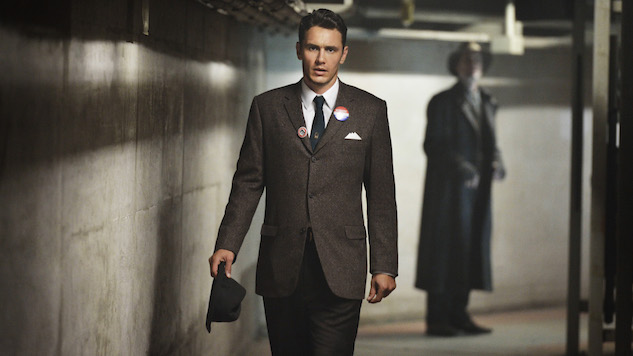
Creator: Bridget Carpenter
Stars: James Franco, Chris Cooper, Sarah Gadon, Cherry Jones
Network: Hulu
When it comes to adapting Stephen King for television, the various attempts over the past 30-odd years could politely be characterized as “iffy.” Then, along came Hulu’s 11.22.63—based on King’s celebrated 2011 novel—to majorly screw with that quality curve. Developed as an eight-episode limited series by Friday Night Lights scribe Bridget Carpenter and produced by J.J. Abrams and King himself, 11.22.63 stars James Franco as Jake Epping, a recently divorced English teacher who learns that his friend, Al (Chris Cooper), has been attempting to prevent the assassination of John F. Kennedy via a time portal in the back of his diner. When Al is unable to continue the mission, Jake assumes the mantle and travels back to 1960, where he must spend the next three years meticulously plotting to hinder Lee Harvey Oswald’s world-changing murder, all while the forces of time throw obstacle after obstacle in his path. The series has been whittled down from King’s 800-plus page opus, and as a result, some of the plot elements feel a tad rushed, while others seem like little more than glorified filler. That said, the emotional core of the piece is present, especially with regard to Jake’s relationship with a beautiful young librarian (Sarah Gadon). What’s more, the narrative’s final stretch is tense and suspenseful. Though calling 11.22.63 the “best Stephen King miniseries of all time“ might sound like a backhanded compliment, it’s a moving and honest-to-God enthralling bit of sci-fi wizardry. —Mark Rozeman
39. Philip K. Dick’s Electric Dreams (2018-)
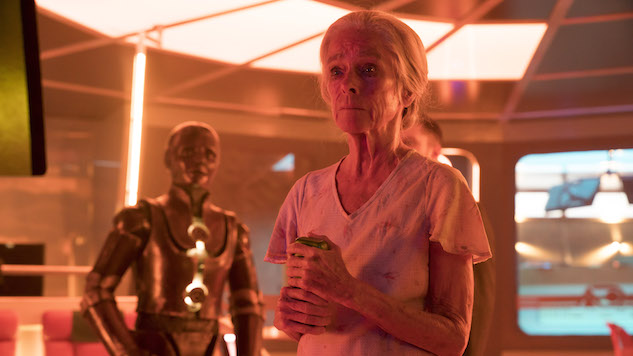
Creators: Ronald D. Moore, Michael Dinner
Stars: Steve Buscemi, Greg Kinnear, Anna Paquin, Terrence Howard, Vera Farmiga, Mel Rodriguez, Juno Temple, Maura Tierney, Annalise Basso
Network: Amazon
If you’re in the mood for some serious dystopian foxfire, riddled with existential dread and quirkily romantic, you’re in for a treat. This anthology of wonderfully filmed episodes can be seen in whatever order pleases you, and the subject, style and genre vary broadly, though the episodes share a sumptuous production sensibility and terrific casting. The what-ifs span numerous worlds and times and alternate realities, but each questions the fundamental human-ness of humans and they do it in some awfully clever and affecting ways. Timothy Spall plays a railway worker who finds himself in an alternate world where that thing you wish hadn’t happened actually never did. Geraldine Chaplin plays a 300-year-old woman on a mission to see Earth before she dies. Jack Gore’s father (Greg Kinnear) is replaced by an alien, and no, it’s not an overactive imagination and angst about his parents’ imminent divorce: The dude’s an alien. Each episode is richly imaginative, directed with seat-edge-gripping tension, and peopled with strikingly strong performers (Chaplin, Spall, and Benedict Wong, as a cynical tour-spaceship operator, are standouts, but there’s not really any significant dead space here). Some are post-apocalyptic, some are not. Some have a decidedly dystopian feel and some are just plain old neurotic. Each clocks in at a little under an hour, and while sci-fi isn’t always my go-to genre, I didn’t find a single episode of Philip K. Dick’s Electric Dreams to be anything but compelling. —Amy Glynn
38. Agents of S.H.I.E.L.D. (2013-)
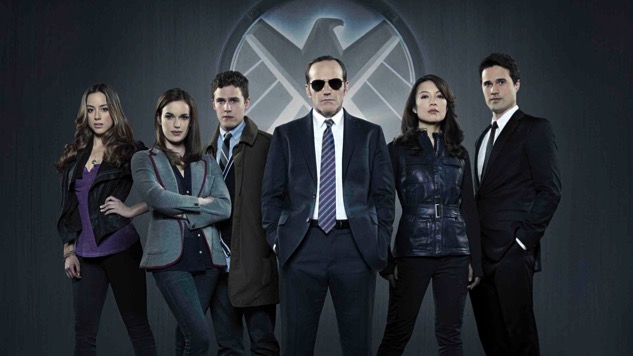
Creators: Joss Whedon, Jed Whedon, Maurissa Tancharoen
Stars:: Clark Gregg, Ming-Na Wen, Brett Dalton, Chloe Bennett, Iain De Caestecker, Elizabeth Henstridge, Nick Blood, Adrianne Palicki
Network:: ABC
Nothing in S.H.I.E.L.D. ever stays the same for long. It is this vital characteristic that allowed the show to endure a series of early rough patches that not even Phil Coulson’s (Clark Gregg) flying car could avoid. This element would also end up making the series unique. A re-watch of the beginning of the show’s first season almost feels like the launching point for a different series. Each week found Coulson and his team of agents going on a wacky new spy-laden adventure. Though intended to be fun and lively, the show reached a little too far over the top, resulting in an awkward feeling of camp (think Roger Moore’s Bond films) that simply didn’t mesh with the world the Marvel films established. Then, in 2014, as the show’s first season began its final arc, Captain America: The Winter Soldier happened. The events of the Captain America sequel tied in heavily with the S.H.I.E.L.D. TV series, and it finally felt like it belonged within the MCU instead of being relegated to the outside looking in. Ironically, H.Y.D.R.A.’s attempt at destroying S.H.I.E.L.D. proved to be the show’s saving grace. The series often turns on a dime, but the viewer never feels whiplash. An impressive accomplishment given the multitude of times this show could have easily veered off the rails. Always remaining in a state of reinvention, no two seasons are alike. Revolving team lineups keep the character dynamics fresh, and the audience can never fully guess which direction the series is going to head next. This sense of ballsy exploration keeps the narrative from ever becoming stale, resulting in a show that is both criminally underrated and underappreciated. Marvel’s Agents of S.H.I.E.L.D. absolutely belongs in the upper echelon of Marvel’s catalogue, be it works from the small screen or the silver one. —Geoff Miller
37. Chuck (2007-2012)

Creators: Josh Schwartz, Chris Fedak
Stars: Zachary Levi, Yvonne Strahovski, Joshua Gomez, Sarah Lancaster, Adam Baldwin, Ryan McPartlin, Mark Christopher Lawrence, Scott Krinsky, Vik Sahay, Julia Ling, Bonita Friedericy
Network: NBC
Chuck was a show that took various genres, including sci-fi, comedy, action and drama, and melded them all together like a blender. The thing that tied these divergent tones together, however, was the sense of boundless fun and enthusiasm that permeated every aspect of the show, from the cast’s fantastic performances (Zachary Levi deserved an Emmy for his work) to the exciting action set pieces to the dynamite soundtrack (thank you, Josh Schwartz and Alexandra Patsavas for the endless stream of bands like Bon Iver, The Shins, Beck, Frightened Rabbeit, The National, Gnarls Barkley and Band of Horses). The show, which told the story of a regular guy who, by chance, got U.S. intelligence downloaded downloaded directly into his brain to become the government’s most valued secret agent, lived under the perpetual threat of cancellation. So, when the end finally came, the writers were ready. For five seasons, our nerdy everyman accompanied sexy superspy Sarah and the grumpy John Casey on life-threatening, top-secret missions. Slowly but surely, despite the obvious setbacks, Sarah and Chuck fell in love with each other, but whether their biggest setback could be overcome was left somewhat ambiguous. But with Chuck being Chuck, one can be assured that there is always a sense of hope. —Mark Rozeman
36. Fringe (2008-2013)

Creator: J. J. Abrams, Alex Kurtzman, Roberto Orci
Stars: Anna Torv, Joshua Jackson, John Noble, Jasika Nicole, Lance Reddick
Network: Fox
Like Lost, J.J. Abrams’s Fringe starts as a masterful slow-burn. The first season drops copious hints at the show’s central mythology, but doesn’t put all its cards on the table until the end of an unforgettable season finale. Until then it’s a paranormal procedural in the vein of X-Files; after that point it’s a tense, unsettling tale of two parallel dimensions at war with one another, sometimes unwittingly. Unlike Lost, Fringe remains well-paced throughout its final four seasons, popular enough to keep getting renewed and finish out its story, but not a Lost-style blockbuster that has to prolong and complicate its story to meet a network’s demand for more content. Fringe wasn’t as powerful or moving as Lost ultimately proved to be, but it was a far more focused and deliberate show, which makes it stronger and more satisfying in many ways. And John Noble’s turn as Walter Bishop, a brilliant scientist struggling with diminished mental faculties and his own guilt over his interactions with the parallel dimension he discovered, is one of the best and most heartbreaking performances in recent TV history. —Garrett Martin
35. Life on Mars (2006-2007)
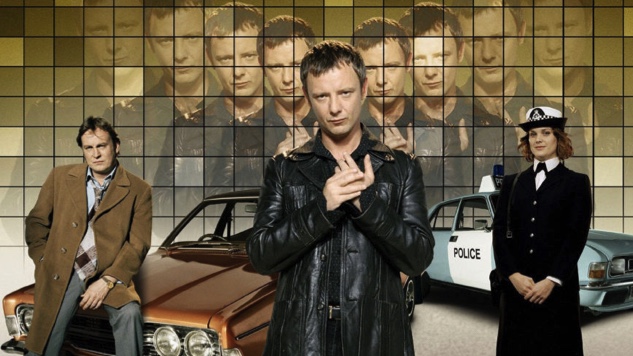
Creators: Matthew Graham, Tony Jordan, Ashley Pharoah
Stars: John Simm, Philip Glenister, Liz White, Dean Andrews, Marshall Lancaster
Network: BBC One
In this British a cop show with a sci-fi twist, Detective Sam Tyler (John Simm) is a 21st-century Manchester police officer who wakes up to find himself in 1973 after getting hit by a car. With no idea whether he’s “a time-traveler, a lunatic or lying in a hospital bed in 2006 and none of this is real,” he copes as best he can, trying to do police work without the benefits of modern technology. What makes the show great, though, is its exploration of misogyny and abuse of power on the ’70s police force. Tyler’s modern sensibilities are at odds with the rest of the boys in the police department, particularly DCI Gene Hunt (played brilliantly by Philip Glenister), who rides roughshod over suspects’ rights and well… anyone or anything else who stands between him and closing a case. As the show progresses, though Tyler keeps searching for his own truth, he starts to make the best of a strange situation. The show spawned both a spin-off Ashes to Ashes and a short-lived American remake. —Josh Jackson
34. Star Trek: Discovery (2017-)

Creators: Bryan Fuller, Alex Kurtzman
Stars: Sonequa Martin-Green, Doug Jones, Shazad Latif, Anthony Rapp, Mary Wiseman, Jason Isaacs, Wilson Cruz, Anson Mount
Network: CBS All Access
The latest Star Trek prequel lacks the optimism that Gene Roddenberry infused into the franchise, but considering it takes place during the Klingon War that preceded Star Trek: The Original Series, that’s understandable. At the center of the latest iteration is Michael Burnham (played by The Walking Dead’s Sonequa Martin-Green), a human raised by Vulcans whose mutinous actions inadvertently start the catastrophic war. Despite a jail sentence, she’s recruited by the Captain Gabriel Lorca (Harry Potter’s Jason Isaacs) to serve as science officer on Discovery, a ship with a teleportation drive unique to among Federation ships that leads to an unexpected plot twist. CBS greenlit the show to help launch their All Access subscription package. The tone is a big break from previous entries in the Star Trek universe, but the set design is gorgeous and the acting (including The Shape of Water’s Doug Jones, Penny Dreadful’s Shazad Latif, Crouching Tiger, Hidden Dragon’s Michelle Yeoh and Broadway star Anthony Rapp) is top-notch. —Josh Jackson
33. FLCL (2000)
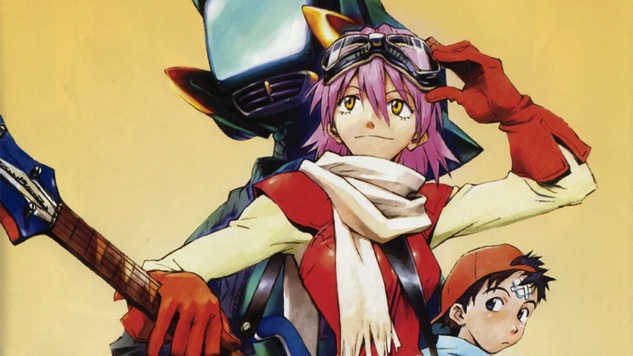
Creator: Y?ji Enokido, Kazuya Tsurumaki
Stars: Mayumi Shintani, Jun Mizuki, Inori Minase, Karen Miyama, Jun Fukuyama
Network: Adult Swim
FLCL was intended to feel unlike anything else you’ve ever watched, anime or otherwise. It’s got an incredible Japanese alt-rock soundtrack from the band The Pillows. Its editing is frenetic. Its characters interact in extremes of manic, moody, or forlorn. Its plot—in which robots pop out of a young boy’s swollen, injured head, heralding the return of a powerful extraterrestrial being—kinda doesn’t matter. None of that stuff matters, according to series director Kazuya Tsurumaki. “Difficulty in comprehension should not be an important factor in FLCL,” he once wrote in a comment thread for Production IG. “I believe the ‘rock guitar’ vibe playing throughout the show is a shortcut on the road to understanding it.” Rock on, brother. —Eric Vilas-Boas
32. The OA (2016-)

Creators: Zal Batmanglij, Brit Marling
Stars: Brit Marling, Jason Isaacs, Scott Wilson
Network: Netflix
Brit Marling and Zal Batmanglij’s flawed, transfixing science (or is it spiritual?) fiction asks its audience, as the title character (Marling) does hers, for trust—to the point that the suspension of disbelief emerges as the subject of The OA, and not merely its mechanism. As the OA, or Original Angel, also known as Prairie Johnson, unfurls a tale of unimaginable trauma for four high school students and their math teacher (the surprising Phyllis Smith), the decision to focus on images of their rapt faces might appear premature, given the first season’s meandering course. And yet, mirroring the OA’s inscrutable message, Marling and Batmanglij’s snarled stories ultimately straighten, as if diagramming an indecipherable sentence or lining a complex hymn: When its nesting narratives come taut, when its forked paths converge, The OA rewards the faith it requires, coming to a climax of such sublime conviction it continues to reduce me to sobs even now, after countless viewings. —Matt Brennan
31. The Flash (2014-)

Creators: Greg Berlanti, Andrew Kreisberg, Geoff Johns
Stars: Grant Gustin, Candice Patton, Danielle Panabaker, Rick Cosnett, Carlos Valdes, Tom Cavenagh
Network: The CW
Over the past five years, the CW, born from a merger of The WB and UPN in 2006, has taken full advantage of its close ties with Warner Bros. to hand over much of its primetime slate to DC superhero shows, and it’s one of the most fun line-ups on television, especially with Barry Allen zipping around National City in The Flash, taking out bad guys with a quip and a smile. The Flash has tackled everything from the classic Flashpoint storyline about alternate realities to the giant, super-intelligent Gorilla Grodd, and fans are eating it up. At heart, comic books were designed as a fantastical distraction from everyday life. That doesn’t mean they can’t tell meaningful stories that push us to reexamine our world, but it’s taken time for the balance we see on the page to make the leap to the screen. With big-screen superhero stories becoming so bruising, both mentally and physically, small-screen comic stories are now a light-hearted oasis for fans just looking to have a good time, with a little angst thrown in for good measure. —Trent Moore
30. Dollhouse (2009-2010)
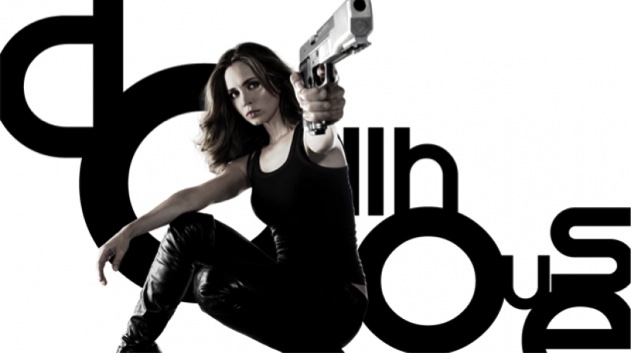
Creator: Joss Whedon
Stars: Eliza Dushku, Harry Lennix, Fran Kranz, Tahmoh Penikett, Enver Gjokaj, Dichen Lachman, Olivia Williams
Network: Fox
Between Buffy and The Avengers, Joss Whedon had a habit of creating good shows that got canceled too soon. Dollhouse was no Firefly, but after a weak first season that focused on singular missions from Eliza Dushku’s character, it expanded into a fascinating sci-fi universe. The premise of the show was that brain-wiping technology could allow the techs of the Dollhouse to install different personalities and skills in their blank-slate agents. In the first season, this just felt weirdly exploitative for the viewer, but the sweeping arc of the second season began to question the ethics of imagined technologies and turn the first season’s plotlines on their heads. And the payoff was huge with an epic two-episode apocalyptic flash-forward that ended each season, starring Felicia Day as a survivor of the Dollhouse technology gone viral. —Josh Jackson
29. Future Man (2017-)

Creators: Howard Overman, Kyle Hunter and Ariel Shaffir
Stars: Josh Hutcherson, Eliza Coupe, Derek Wilson, Glenne Headly, Ed Begley, Jr.
Network: Hulu
The cure for herpes creates a dystopian divide between humans and mutant beings. Yeah, that’s the setting for one of the strangest, most compelling pieces of sci-fi comedy on television in recent memory. Future Man comes from the minds of Seth Rogen and Evan Goldberg, both of whom are masters at genre tweaking. This genre gets tweaked a bit more than most—things get wet and wild almost immediately with some botched time travel, some plot points lifted from The Last Starfighter, and a talking house owned by James Cameron. Yes, that James Cameron. The silliness wouldn’t hold together unless it was seriously acted and the show has a killer cast, unlocking Josh Hutcherson’s potential as a comedy straight man and introducing newcomer Derek Wilson as a fish-out-of-water force. The gags are R-rated, sharp and quick inside the sci-fi pastiche, which makes the absurd dedication to plotting and nuanced characters so entertaining. —Jacob Oller
28. Black Mirror (2011-)

Creator: Charlie Brooker
Network: Channel 4 (UK), Netflix
There are probably times in most of our lives when we see our technological world as more of a dystopia than a utopia. The way it curbs our freedom, diminishes our privacy, and subjects us to anonymous attacks can feel like an unforgivable violation. But the worst part is, we’re complicit—we’ve accepted the intrusion, and in some cases, or even most cases, we’ve become addicted. The ubiquity of technology is a reality that we can’t fight against, and to maintain our sanity, we have to accept it. But that doesn’t mean it’s not worth questioning, which is exactly what Black Mirror is all about. The title is nearly perfect, as explained by creator Charlie Brooker: “The black mirror of the title is the one you’ll find on every wall, on every desk, in the palm of every hand: the cold, shiny screen of a TV, a monitor, a smartphone.” The job of this show is to reflect our society in an unflattering light, and they do it with a new cast and a new story in each episode. This is not fun watching—it’s mostly horrifying—but even if our brave new world is inescapable, the show represents a kind of protest that feels more necessary than ever. —Shane Ryan
27. Mystery Science Theater 3000 (1997-2004, 2017-)
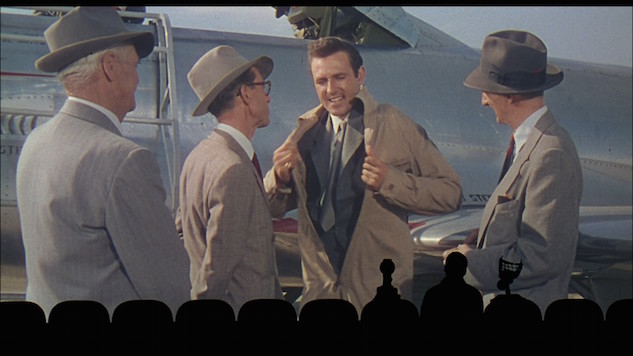
Creator: Joel Hodgson
Stars: Felicia Day, Patton Oswalt, Jonah Ray, Baron Vaughn, Hampton Yount, Joel Hodgson, Trace Beaulieu, Josh Weinstein, Jim Mallon, Kevin Murphy, Frank Conniff, Michael J. Nelson, Mary Jo Pehl, Bill Corbett, Patrick Brantseg
Network: KTMA, Comedy Central, SyFy, Netflix
From the depths of Minneapolis public access TV came MST3K, the show that forever changed how comedians (and comedy audiences) viewed the act of watching bad movies. Joel Hodgson’s brainchild transformed an act carried out by stoned college kids watching late night TV into some of TV’s sharpest comedy writing, leaving an indelible mark on the comedy world and inventing an entire subgenre of professional comedic exploration while he was at it: Movie riffing. At its creative peak during both the Hodgson and Michael J. Nelson years, there wasn’t a show on television that featured denser, more joke-packed episodes, while simultaneously covering such a wide, eclectic range in its pop cultural references. That cosmopolitan comedy legacy now lives on via the Netflix revival of the show, MST3K: The Return, which has one season in the tank and another on the way. Although the reboot hasn’t quite reached the heights of the show’s original run just yet, there’s reason to hope that it will continue rounding into form. Check out our massive ranking of every single episode of MST3K ever made. —Jim Vorel
26. Neon Genesis Evangelion (1995)
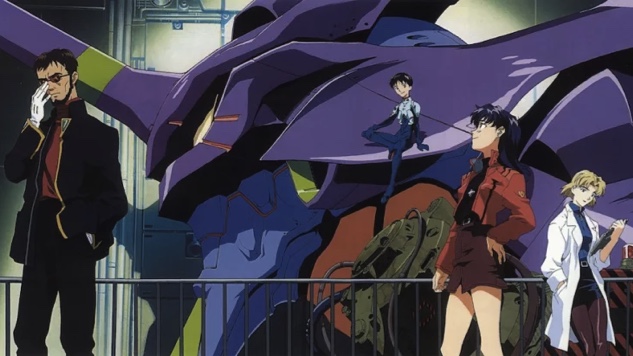
Creator: Hideaki Anno
Stars: Hideaki Anno, Kazuya Tsurumaki, Hiroyuki Ishidô, Tsuyoshi Kaga
Network: Animax, Cartoon Network
Is it a psychodrama about growing up? Is it a giant robot action show about the apocalypse? Is it an allegory for how humans are doomed and can’t communicate? If Neon Genesis Evangelion seems like a figurative roller coaster, guess what: it has an actual VR roller coaster, too. The thing is, Evangelion does manage to find treasure in all its complex digging into those questions, and it never feels bloated or boring in the process. Series director Hideaki Anno frames his characters’ traumas through horror imagery; crucifixion, sexual misconduct, child abuse, and the literal melting of humankind are all ideas he visually worked into this crazy, decades-spanning franchise. In the hands of someone else, it’d probably fall apart completely. Evangelion, however, is beautiful enough to use a cover of “Fly Me to the Moon” as its credits track and make it all work. —Eric Vilas-Boas
25. Babylon 5 (1994-1998)

Creator: J. Michael Straczynski
Stars: Bruce Boxleitner, Michael O’Hare, Claudia Christian, Jerry Doyle, Mira Furlan, Richard Biggs, Andrea Thompson
Network: PTEN, TNT
Babylon 5 was certainly one of the decade’s most mature science fiction series, set in a universe where man has taken to the stars and come together with other spacefaring races to build a massive space station for trade, diplomacy and cultural exchange. A rare example of a series that carried out the exact number of seasons (five) it initially planned, it was as such well-planned from the start and featured deep continuity. Compared to the various Star Trek series of the decade, it most closely resembled Deep Space Nine, which aired its pilot only weeks before Babylon 5 debuted. Unsurprisingly, there were myriad accusations out there of which show had the more original idea, but despite lacking the prestige of the Star Trek name, Babylon 5 more than managed to hold its own. —Jim Vorel
24. Stargate SG-1 (1997-2007)
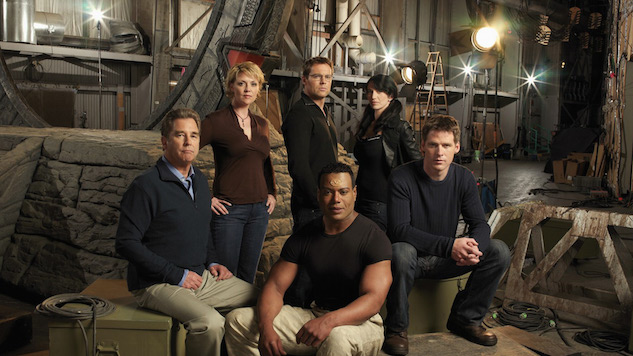
Creator: Brad Wright, Jonathan Glassner
Stars: Richard Dean Anderson, Michael Shanks, Amanda Tapping, Christopher Judge, Don S. Davis, Teryl Rothery, Claudia Black, Ben Browder, Beau Bridges
Network: Showtime, SyFy
The Stargate movie was really a perfect choice to spin off into a sci-fi series because the Stargate itself is quite the piece of deus ex machina—it can transport people all over the galaxy to different planets, so there was always somewhere new and strange to visit, even over the course of 10 seasons and 214 episodes. MacGyver himself, Richard Dean Anderson, took over the role that Kurt Russell played in the film, but the greatest role is probably Teal’c, the “warrior race” alien (let’s be honest, they were thinking “Klingon”) with a rather disturbing biological secret: He’s an incubator to a parasitic monster that gives him enhanced abilities but will one day kill him. Just hearing him talk about the sentient worm in his “abdominal pouch” made for some great, icky sci-fi moments. The show originated on Showtime, but Syfy took over with a slightly lower budget for the final five seasons (2002-2007) before launching two inferior spin-offs (Stargate Atlantis and Stargate Universe). —Jim Vorel
23. Torchwood (2006-2011)

Creator: Russel T. Davies
Stars: John Barrowman, Eve Myles, Bum Gorman, Naoko Mori, Gareth David-Lloyd, Freema Agyeman, Bill Pullman
Original Network: BBC
A spin-off of long-running BBC series Doctor Who, Torchwood retained some of its predecessor’s campy fun, but also seemed to be reaching for the gritty realism that had understandably escaped most sci-fi shows until Ronald D. Moore’s Battlestar Galactica remake redefined what sci-fi could be. By the second season, creator Russel T. Davies seemed to conclude that Torchwood would be better suited to leave the frivolity for the good Doctor, and let Harkness go to darker places. The five-episode story-arc “Children of the Earth,” is a nail-biting, epic story that never lets up and finishes with its biggest punch to the gut. Like Moore’s Battlestar Galactica, Davies has not only reimagined a classic series, he’s used his new extraterrestrial platform to explore the depths of human nature. —Josh Jackson
22. The Expanse (2015-)
Creator: Mark Fergus and Hawk Ostby
Stars: Thomas Jane, Steven Strait, Shohreh Aghdashloo, Paulo Costanzo
Network: SyFy
In Syfy’s The Expanse, Mars and Earth are two superpowers racing to gain the technological upper hand, while those who live in the Asteroid Belt mine resources for the more privileged planets and become more and more prone to radicalization. Sound familiar?
In its relationship to our own age of authoritarianism, the series offers a kind of storytelling that seems essential: It manages to paint a portrait of a divided universe without vilifying one group and raising the other to god-like status, as evidenced by the complexities of hardboiled detective Joe Miller (Thomas Jane) or U.N. official Chrisjen Avasarala (Shohreh Aghdashloo). The Expanse shows us a possible future, a future in which women can be leaders without the bat of an eye, in which racially diverse groups can unite in common cause, but it is also a warning about keeping institutions in check, about recognizing inequality wherever it might exist, in order to avoid past mistakes. In other words, it’s must-watch television for our time. —Elena Zhang
21. Westworld (2016-)
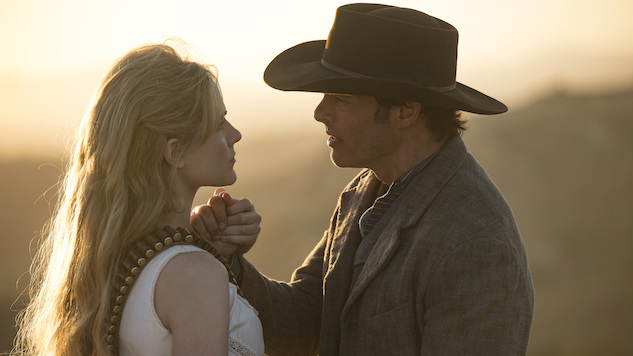
Creators: Jonathan Nolan, Lisa Joy
Stars: Evan Rachel Wood, Thandie Newton, Jeffrey Wright, James Marsden, Ed Harris, Anthony Hopkins, Jimmi Simpson, Shannon Woodward
Network: HBO
Westworld debuted with some big shoes to fill. The would-be successor to HBO’s Game of Thrones got weird fast and didn’t care who was along for the ride. There’s something commendable about that, even if its first season offered more frustration and pretension than fun. Its sophomore season shakes off the shackles of expectation and embraces the characters that (against all odds) dot its endless mysteries with pockets of genuine depth. Rather than having to answer a trick question, viewers have been allowed to experience the android-driven theme park/bacchanalia in the context of the people (and robo-people) living in and around it. Some of the best female performances on TV are lodged inside a show which was so male-gazey in its first season that the irony is as thick as its plot—but if ever there was an award for Most Improved Series on Television, Westworld deserves it. —Jacob Oller
20. Farscape (1993-2003)
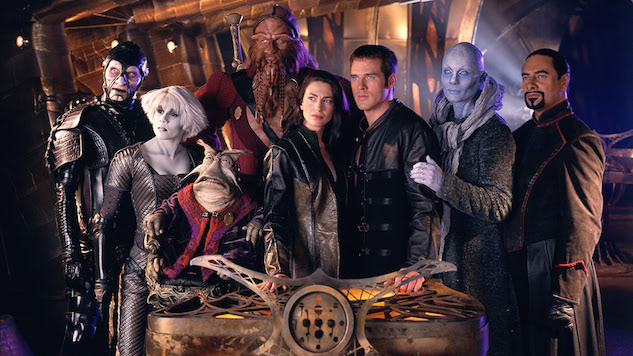
Creator: Brian Henson, Rockne S. O’Bannon
Stars: Ben Browder, Claudia Black, Virginia Hey, Anthony Simcoe, Gigi Edgley, Paul Goddard, Lani Tupu, Wayne Pygram, Jonathan Hardy
Modern day astronaut John Crichton (sci-fi names) is testing an experimental aircraft when he is hurled through a wormhole and winds up in a living spaceship called the Moya with a crew desperately trying to get away from space fascists called peacemakers. Farscape is an ensemble-driven space drama in the vein of Firefly. Unlike, Firefly, it has more than one season. Episodes explore sci-fi premises like alternate realities, omnipotent aliens and space bugs (y’know, those space bugs) while also developing each of the Moya’s crew members and filling in their backstories. Think Mass Effect if Shepard made a bunch of nerdy pop culture references. Plus, if the living spaceship thing didn’t tip you off, things get pretty weird, and occasionally pretty silly. —Harry Mackin
19. Orphan Black (2013-2017)
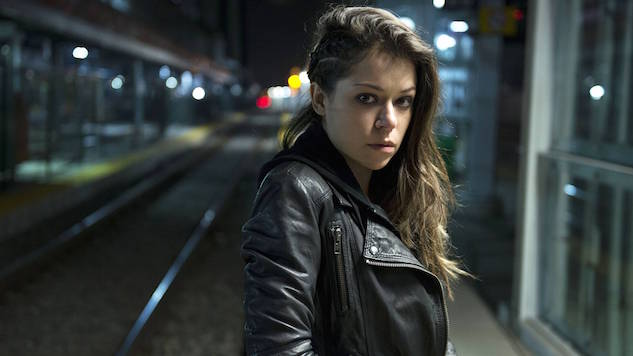
Creators: Graeme Manson, John Fawcett
Stars: Tatiana Maslany, Dylan Bruce, Jordan Gavaris, Kevin Hanchard, Michael Mando, Maria Doyle Kennedy
Network: BBC America
Having one actor play several characters in a single show is nothing new. But that doesn’t take away from what Tatiana Maslany accomplished in the first season of BBC America’s Orphan Black. Maslany plays a host of clones on a sci-fi show that’s not just for sci-fi fans. Her main character, Sarah Manning, is a young British mother living in Canada. A small-time con artist, she’s trying and failing to get her life together when she sees her doppelgänger commit suicide by stepping in front of a train. After stealing the woman’s purse and identity, Sarah the con artist becomes Beth the cop, scrambling to fool her partner and discovering more women who look just like her. Each one she comes across—the uptight suburban mom, the gay hipster scientist, the Ukrainian religious fanatic—feels like such a different character that it’s easy to forget that the same actress is behind them all. And though there are elements of sci-fi—human cloning and the Neolutionists who believe in scientifically improving themselves (one character has a tail)—most of the characters aren’t the type who would even watch sci-fi. The show is as much about identity and motherhood as it is the consequences of technology. But none of it would work without the humanity Maslany brings to each of the clones she portrays in the show. —Josh Jackson
18. Legion (2017-)
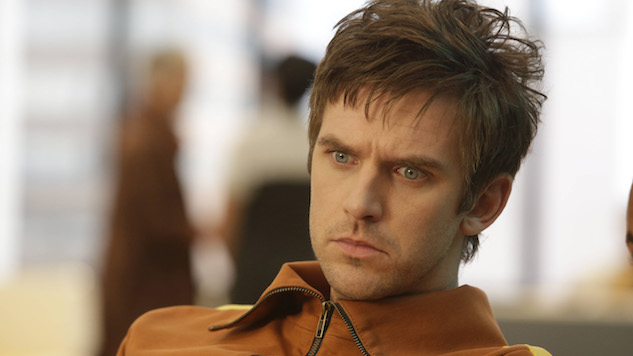
Creator: Noah Hawley
Stars: Dan Stevens, Rachel Keller, Aubrey Plaza, Bill Irwin, Jean Smart, Jeremie Harris, Amber Midthunder, Katie Aselton
Network: FX
The last few years have seen, if not the creation of the bat-shit crazy fantasy, at least its blossoming. Shows like Preacher, Dirk Gently’s Holistic Detective Agency and Happy! are all packed with the weird, the impossible and the insane, each seemingly trying to outdo the others. Each character is more outlandish than the next: an Irish vampire, a holistic assassin, an imaginary flying unicorn voiced by Patton Oswalt. But the champion of bat-shit crazy TV is FX’s Legion, whose characters, both real and imagined, meet in an actual ward for the insane. The first season of Legion proved that Marvel was willing to experiment with a very different kind of superhero show from their movie, ABC and even Netflix formulas. But the second season has somehow found a new gear of surreality now that David and his friends work for the shadowy Division III that was hunting them down in Season One. It’s headed by a guy wearing a basket on his head who communicates through a trio of mustachioed Auto-Tuned mechanical women. The security forces are made up of children. And the story is often broken up with eccentric interstitials narrated by Jon Hamm. Like all good bat-shit crazy TV shows, every scene feels like a riff on the dream sequences from Twin Peaks. But what really separates Legion from its absurdist brethren is acting and writing usually reserved for the rarified airs of prestige drama. Dan Stevens, Rachel Keller, Aubrey Plaza were all given scenes to ravenously devour, and Navid Negahban was introduced as the year’s best villain not named Killmonger. But it’s creator Noah Hawley’s vision, ambition and impishness that has made a comic-book show about mental illness so bleak and yet so fun. —Josh Jackson
17. Mobile Suit Gundam (1979)
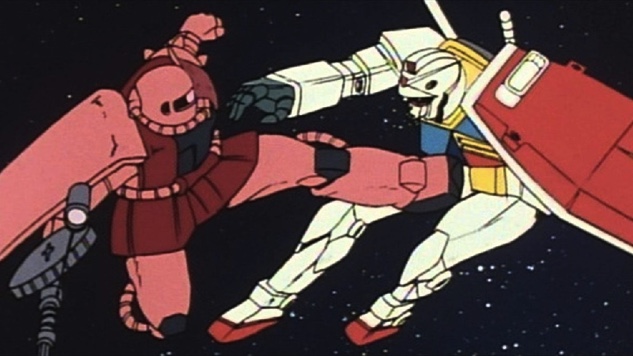
Creator: Yoshiyuki Tomino
Stars: Tôru Furuya, Alaina Burnett, Chris Kalhoon, Michael Kopsa
Network: Nagoya, Animax, Cartoon Network
In 2018, it’s easy to forget—considering the countless spinoff series, films, manga, and model kits—that this legendary 1979 mecha anime was… really, really freakin’ good. The animation may look dated. The mechanical designs and character models may not move with the consistency of the later series. And the implications of its world-building, in which a separatist faction of humans abandons Earth for space colonies, hadn’t been perfectly fine-tuned. Nonetheless, Mobile Suit Gundam’s core arguments hold up four decades later: The people we ask to fight for us—often before they can maturely engage with the world—come back broken or don’t come back at all; Nazis and Nazi-lookalikes are bad; and giant robots are compulsively watchable. —Eric Vilas-Boas
16. Quantum Leap (1989-1993)
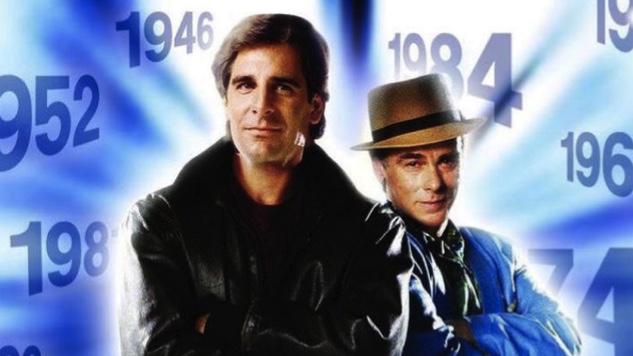
Creator: Donald P. Bellisario
Stars: Scott Bakula, Dean Stockwell
Network: NBC
What a goofy show Quantum Leap truly was. Scott Bakula plays Dr. Sam Beckett, a quantum physicist who becomes trapped in a morphing time loop after an experiment gone awry. In each episode, he leaps into the body of another person (man, woman or child) in a different historical time and must “put right what once went wrong” before jumping into a new body. It’s perfect episodic structure, and it allowed the sci-fi series to set each episode in literally any time period and setting it felt like taking on that week. Likewise, the body-jumping mechanic meant any number of guest stars could appear and Dr. Sam could go anywhere—he even leaps into the body of a chimpanzee in one episode. Despite the silly premise, though, the series actually had a surprising amount of heart as well, largely motivated by Beckett’s unfailing resolve to return to his own time and body and reclaim his own life and identity. In some respects, it’s like a time-traveling version of The Prisoner. —Jim Vorel
15. Agent Carter (2015-2016)
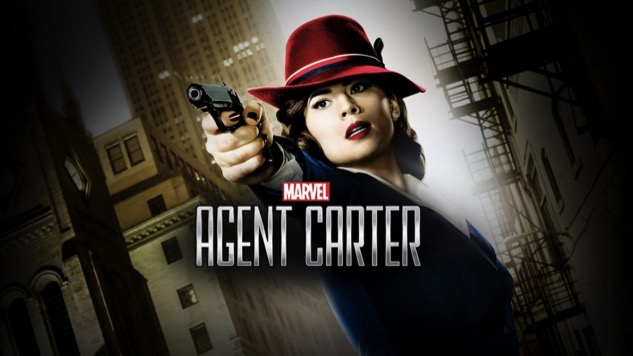
Creators: Christopher Markus, Stephen McFeely
Stars: Hayley Atwell, James D’Arcy, Chad Michael Murray, Enver Gjokaj, Shea Whigham
Network: ABC
Agent Carter, Marvel’s post-S.H.I.E.L.D. series, knew exactly what it was and what it wanted to be from day one: A pulpy, women-centric series of deeply retro sensibilities, built around one of Marvel’s best-liked supporting characters, Peggy Carter, the great love of Steve “Captain America” Rogers and a member of S.H.I.E.L.D. in its fledgling stages. Everything about Agent Carter rings with confidence: The tone and the setting, the style and the characterization, the humor and the action. It’s true that S.H.I.E.L.D. has vastly improved in its subsequent seasons, but Agent Carter didn’t need time to figure itself out (mostly because it didn’t have time to do so). The show doesn’t miss a beat, from its debut all the way up to its finale, rarely winking and nudging along the way with appearances by characters who only matter tangentially in the long run of Marvel’s universe. Most of all, it had Hayley Atwell, whose good looks belie her indomitable toughness, and lead both her audience, her allies, and her enemies alike to underestimate her. She’s the heart of Agent Carter, a story whose female concerns and casting act as a blueprint of sorts for today’s lauded Netflix series Jessica Jones. Captain America might be the first Avenger, but Peggy Carter is the first lady of Marvel ass-kicking. —Andy Crump
14. Futurama (1999-2003, 2008-2013)
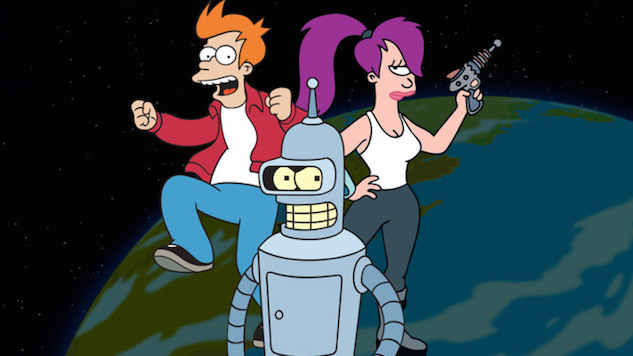
Creator: Matt Groening
Stars: Billy West, Katey Sagal, John DiMaggio, Tress MacNeille, Maurice LaMarche, Lauren Tom, Phil LaMarr, David Herman, Frank Welker
Network: Fox
Totally underappreciated in its original run, which just caught the tail end of the ’90s, one gets the sense that Futurama at first suffered from misplaced expectations. Knowing it was coming from Matt Groening, perhaps people expected a futuristic version of The Simpsons, but Futurama is fundamentally different in quite a few aspects. Although it was similar in its satirical lampooning of modern (or futuristic) daily life and media, it was also capable of being surprisingly—even shockingly—emotional at times. Just ask anyone who remembers the end of “Jurassic Bark” or “The Luck of the Fryrish,” among other episodes. Likewise, its self-contained continuity was unlike almost every other animated sitcom, with events unfolding in both its first and second run on TV that fundamentally affected the viewer’s perception of earlier plot points. It’s now rightly recognized as one of the best animated comedies ever. —Jim Vorel
13. Star Trek: Deep Space Nine (1993-1999)
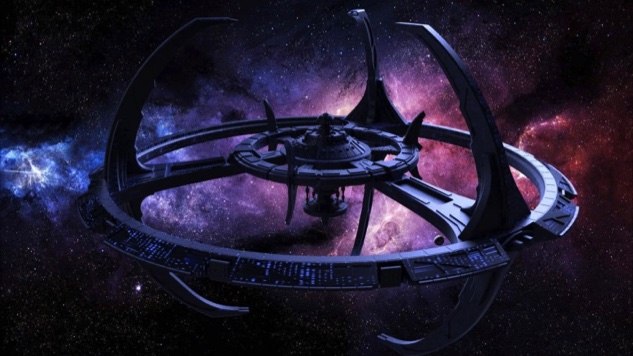
Creator: Rick Berman, Michael Piller
Stars: Avery Brooks, René Auberjonois, Terry Farrell, Cirroc Lofton, Colm Meaney, Armin Shimerman, Alexander Siddig, Nana Visitor, Michael Dorn, Nicole de Boer
Network: Syndication
Deep Space Nine was an experiment in a different type of Star Trek property, one not built around a spaceship/warship traveling and exploring the edges of the known universe. Rather, DS9 was an advanced but static outpost where emissaries of various alien races came to congregate, trade and conduct business. The show featured the first and still only black commander-in-chief as lead protagonist and was noted for the diversity of its alien cast and their well-defined characters. It also tackled topics of religion more effectively and extensively than any of the Star Trek series to date, as the Bajoran Wormhole near DS9 was integral to both the series’ plot and the religious beliefs of the Bajoran people, several of whom served as crew. It was never quite as popular as Next Generation, but that was a tough assignment to follow. —Jim Vorel
12. The Prisoner (1967-1968)

Creators: Patrick McGoohan, George Markstein
Stars: Patrick McGoohan
Network: ITV
It almost seems like an insult to call The Prisoner a sci-fi show—it’s really not science fiction, at least not in the way that Star Trek or Dr. Who are. Patrick McGoohan’s cult classic is a surreal psychological thriller where almost everything remains a mystery, both to the viewer and to McGoohan’s character, who is only known as Number 6. It’s an allegorical look at humanity’s role in society and how power structures crush the individual, like a more confusing cousin to 1984. It’s also impossible to argue that it’s not sci-fi, though—between the psychedelic atmosphere of The Village, the otherworldly set design of Number Two’s control room, the often futuristic edge to Number Two’s various schemes to break Number Six, and the straight sci-fi horror of Rover, the giant white balloon who kept prisoners from escaping The Village, it’s prime speculative fiction that could’ve been written by somebody like Harlan Ellison (who once hosted a Prisoner marathon on cable in the early ’90s). It’s a better show than it is a sci-fi show—and should be seen by anybody who takes TV seriously as a narrative medium—but its sci-fi aspects can’t be denied. —Garrett Martin
11. Rick and Morty (2013-)
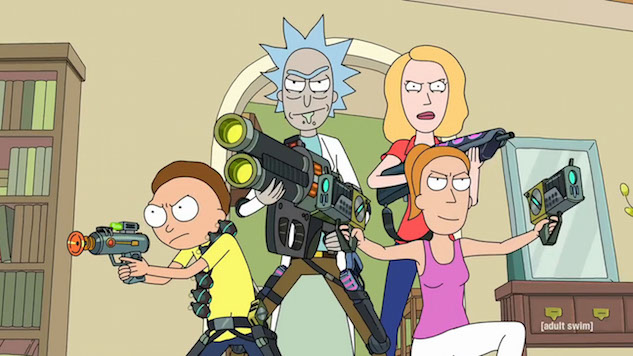
Creators: Dan Harmon, Justin Rolland
Stars: Justin Rolland, Chris Parnell, Spencer Grammer, Sarah Chalke
Network: Adult Swim
Anticipation for each new season of Justin Roiland and Dan Harmon’s series peaks higher, and for good reason: It’s one of the most brilliant shows on television. Unlike The Big Bang Theory, it uses its nerdiness and intelligence not as a gimmick, but as a way to open the (literal) dimensions of creative possibility, whether the ideas are original (interdimensional cable, a sentient gas cloud named Fart) or tongue-in-cheek homage (to The Purge, Inception, even its own interdimensional cable episode). But behind the innovation is a Eugene O’Neill-ian dysfunction that probes the depths of familial unhappiness, and it’s when Rick and Morty leans into this (especially in episodes like “Total Rick-all” and “The Wedding Squanchers”) that it reaches its most sublime moments. Season Two, in particular, took protagonist Rick Sanchez into a profound depression matched only by BoJack Horseman among animated series. —Zach Blumenfeld
10. Stranger Things (2016-)
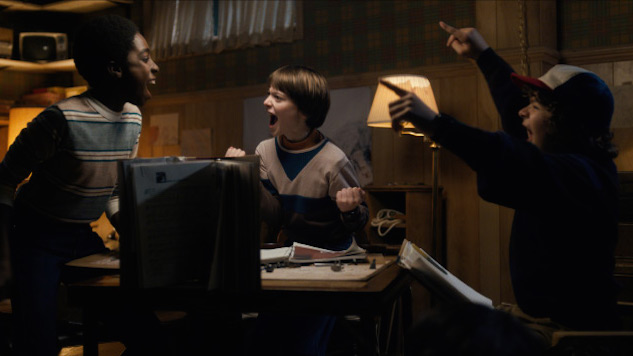
Creators: The Duffer Brothers
Stars: Winona Ryder, David Harbour, Finn Wolfhard, Millie Bobby Brown, Gaten Matarazzo, Caleb McLaughlin, Natalia Dyer, Charlie Heaton, Cara Buono, Matthew Modine
Network: Netflix
The only question viewers tend to ask about the quality of Netflix’s Stranger Things isn’t “Is this a fantastically entertaining show?” but “Does it matter that the show is so homage-heavy?” Our take: No. Since springing into the cultural consciousness immediately with its 2016 release, Stranger Things has been hailed as a revival of old-school sci-fi, horror and ’80s nostalgia that is far more effective and immediately gripping than most other examples of its ilk. The influences are far too deeply ingrained to individually list, although imagery evoking Amblin-era Steven Spielberg, John Carpenter and Tobe Hooper films drips from nearly every frame. In Season One, the stellar cast of child actors and several different characters whose hidden secrets we desperately want to see explored hits every note necessary to motivate a weekend-long Netflix binge. Season Two is full of the same kinds of joyful moments of television—’80s nostalgia, plucky kids, pre-teen awkwardness, scary-but-not-terrifying monsters, goofy minor characters and emotional reunions. The world gets a little bigger than Hawkins, Indiana, and the stakes get a little higher, but at its heart, six kids must face up to their monsters, metaphorical and real, to a perfect ’80s soundtrack. —Jim Vorel and Josh Jackson
9. Firefly (2002-2003)
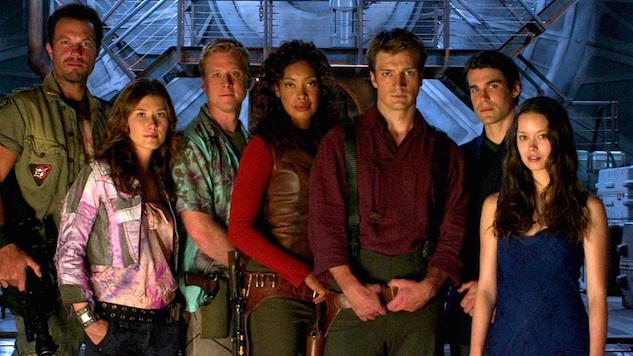
Creator: Joss Whedon
Stars: Nathan Fillion, Gina Torres, Alan Tudyk, Morena Baccarin, Adam Baldwin, Jewel Staite, Sean Maher, Summer Glau, Ron Glass
Network: Fox
Leave it to Joss Whedon to dream up a space show without aliens. The smart writing he brought to Buffy turned the universe into one big frontier, where those who didn’t conform to authoritarian rule were forced to eke out their livings among outlying planets where the long arm of the law couldn’t follow. When Whedon created Malcolm Reynolds as the centerpiece of Firefly, he wanted a hero who is “everything that a hero is not.” Once a sergeant in the losing war for independence, Mal captains a team of misfits in smuggling operations on the edge of the galaxy. His main goal in life is to be left alone and avoid the Alliance government—until he discovers (in the movie Serenity), their heavy-handed plan to fix (i.e., medicate and subdue) the world, at which point he aims to misbehave. He’s broken, bitter and faithless. He’s also damn funny and the one person his crew can count on without reservation. Through his crew, Mal slowly comes to terms with what he’s lost in himself. As Nathan Fillion describes the team his character surrounded himself with: “In Wash, he has a lust for life and a sense of humor he’s lost. In Jayne, he has selfishness. In Book, he has spirituality. In Kaylee, he has innocence. Everybody represents a facet of himself that he has lost and that’s why he keeps them close and safe, and yet at arm’s length.” That dynamic complexity in Mal and in his interactions with the crew are what drew us to Firefly and how a TV show canceled midway through its first season sold 500,000 copies on DVD, launched a major motion picture, spawned two comic book series and inspired rabid fans still actively championing the show. —Paste Staff
8. Lost (2004-2010)
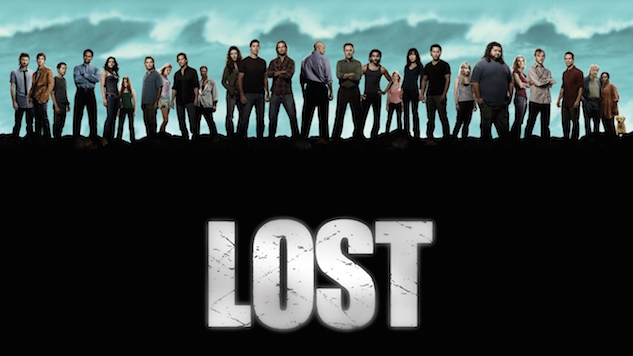
Creators: J.J. Abrams, Jeffrey Lieber, Damon Lindelof
Stars: Matthew Fox, Evangeline Lilly, Naveen Andrews, Michael Emerson, Terry O’Quinn, Josh Holloway, Jorge Garcia, Yunjin Kim, Daniel Dae Kim
Network: ABC
When J.J. Abrams first marooned his plane-crash survivors on a remote island, no one realized the show’s name was a double entendre: It took crowd-sourced blogs to make sense of all the hidden clues, relevant connections, time shifts and intertwined storylines, and each season gave us far more questions than answers. But there was something refreshing about a network TV show that trusted the mental rigor of its audience instead of dumbing everything down to the lowest common denominator. Sometimes it’s good to be a little lost. The writers seemed to want to cram every genre into one TV show and the result was something completely original. Season 1 started as an action-packed thriller, which morphed into mystery, romance, science-fiction and eventually, religious allegory. But there’s certainly enough sci-fi elements—the island’s bizarre magnetic field, the Dharma Initiative experiments, the frozen wheel, time-travel—to put it on this list. —Josh Jackson
7. Cowboy Bebop (1998-2000)

Creators: Shinichir? Watanabe, Masahiko Minami, Keiko Nobumoto
Stars: K?ichi Yamadera, Beau Billingslea, Megumi Hayashibara, Aoi Tada
Network: TV Tokyo, WOWOW
Often revered as the Citizen Kane of anime programs, Cowboy Bebop’s highly Americanized amalgamation of Western tropes, Beat culture and William Gibson-esque steampunk made it a show for all tastes. While much of its 26-episode run consisted of individual adventures that could be viewed in any order, the show’s serialized portions built to a incredible crescendo with the final two-part finale. Set in the year 2071, the premise concerns the various missions of a bounty hunter crew, led by the show’s slick, leisure suit-wearing protagonist, Spike Spiegel. Visually, the creative team takes cues from a proverbial smorgasbord of influence—from steampunk sci-fi to spaghetti westerns to French New Wave— all the while augmenting the show’s striking imagery with a propelling jazz-filled soundtrack. Despite its unquestionable cool sheen, however, Cowboy Bebop is never a style-over-substance experiment, with many episodes probing notions of existential loneliness as well as characters’ deep-seated emotional damage. If ever there was a show that transcended its niche market and achieved greatness, this was the one. Though now two decades old, Cowboy Bebop remains an undisputed masterpiece and a standard by which all other modern anime must aspire. —Mark Rozeman
6. Star Trek: The Original Series (1966-1969)
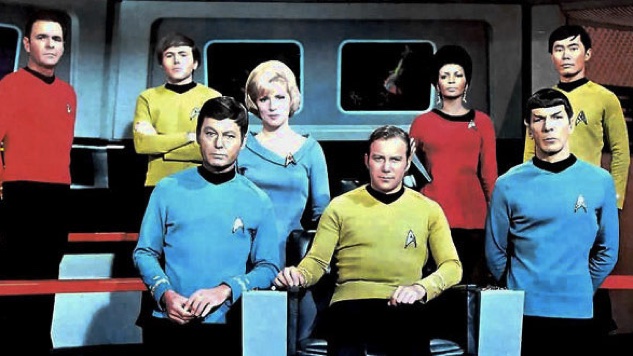
Creator: Gene Roddenberry
Stars: William Shatner, Leonard Nimoy, DeForest Kelley, James Doohan, Nichelle Nichols, George Takei, Walter Koenig
Network: NBC
What began as a pitch by writer and producer Gene Roddenberry about a small spaceship exploring the galaxy has since grown into a worldwide cultural phenomenon inspiring millions of viewers (as well as astronauts, scientists and inventors) for more than half a century. A multi-billion dollar franchise spanning eight TV series, 13 films, countless books, comics, magazines and videogames—that all starts here. Four pinging notes ring out in the silence of space. The voice of Captain James T. Kirk (William Shatner) suddenly echoes out among the stars, explaining his crew’s five-year mission via voiceover narration. Their vessel is the Starship Enterprise, which appears in all its glory, orbiting planets and traveling at high warp, faster than anything that 1960s audiences had ever seen, as fast as progress itself. An alien operatic soprano suddenly wails out, then the theme song by composer Alexander Courage, then the titles: STAR TREK. Everything about this new science fiction TV show would break the mold, from its diverse cast and thought-provoking plots to its art direction. At the end of Season Two, when word had spread that Star Trek was at risk of cancellation, NBC received hundreds of thousands of letter in protest from fans, including doctors, professors and even New York Governor Nelson Rockefeller.The Original Series would be canceled in 1969, the last episode airing fewer than two months before Apollo 11’s successful manned mission to the Moon. But its effect was permanent and immeasurable. Roddenberry had built a series that dared to face the unknown, overcome impossible challenges and stretch social conventions for the better. His dream of the future set the stage for a show that would boldly go where no other TV series had gone before. —James Charisma
5. The X-Files (1993-2002, 2016-2018)
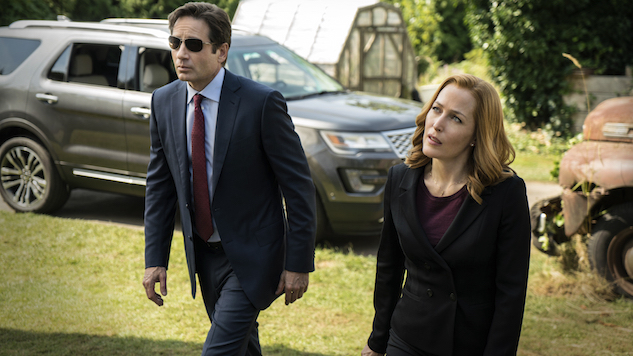
Creator: Chris Carter
Stars: David Duchovny, Gillian Anderson, Robert Patrick, Annabeth Gish, Mitch Pileggi
Network: Fox
Today, after more than 200 episodes, two feature films, a spinoff and a revival, being an X-Files fan is a lot like being a fan of a long-running comic book. Namely, there are peaks and valleys in writing quality, the continuity becomes a convoluted mess if you stop to think about it for even a second and—in spite of whatever monumental changes occur—the story always seems to revert back to a certain status quo. And yet there’s no question that what initially started as creator Chris Carter’s take on Kolchak: The Night Stalker has since become an indelible cornerstone in the history of television. Long before the likes of Buffy or Lost, The X-Files legitimatized the viability of serialized genre storytelling. Alongside stand-alone case episodes, the series incorporated ongoing arcs involving vast government conspiracies, alien invasions and the mystery surrounding a missing loved one. Perhaps more impressive than its long-term thinking, however, was the flexible tone the creative team established as a template for its various installments. Episodes could be scary, funny, surreal, emotional—sometimes all in the same hour. In the world of The X-Files, a horror-filled hour centered on deformed cannibals could fit right alongside a hilarious take-off on Cops. Writing and directing aside, what really tied everything together and made it pop was the legendary chemistry between David Duchovny’s Fox Mulder and Gillian Anderson’s Dana Scully. At the risk of courting controversy, those who simply reduce the two’s dynamic to a simple “will they, won’t they?” are being somewhat reductive. What Mulder and Scully had was more than simple sexual tension; it was a loving and respectful partnership between two intelligent individuals whose differing attributes perfectly complemented one another. It assured us that, despite all the monsters and aliens at play, there was an inherent humanity rooted firmly at the show’s center. —Mark Rozeman
4. The Twilight Zone (1959-1964)
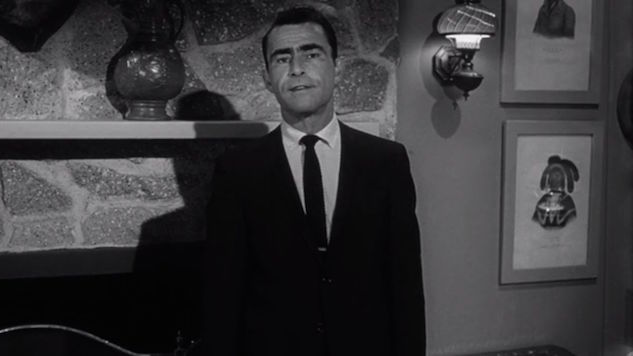
Creator: Rod Serling
Stars: Rod Serling
Network: CBS
It is, in the estimation of any sane person, one of the greatest science fiction series of all time without a doubt, with its myriad episodes about technology, aliens, space travel, etc. But The Twilight Zone also plumbed the depths of the human psyche, madness and damnation with great regularity, in the same spirit as creator Rod Serling’s later series, Night Gallery. Ultimately, The Twilight Zone is indispensable to both sci-fi and horror. Its moralistic playlets so often have the tone of dark, Grimm Brothers fables for the rocket age of the ‘50s and ‘60s, urban legends that have left an indelible mark on the macabre side of our pop culture consciousness. What else can one call an episode such as “Living Doll,” wherein a confounded, asshole Telly Savalas is threatened, stalked and ultimately killed by his abused daughter’s vindictive doll, Talky Tina? Or “The Invaders,” about a lonely woman in a farmhouse who is menaced by invaders from outer space in an episode almost entirely without dialog? Taken on its own, a piece of television such as “The Invaders” almost shares more in common with “old dark house” horror films or the slashers that would arrive 20 years later than an entry in a sci-fi anthology. —Jim Vorel
3. Doctor Who (1963-1989, 2005-)
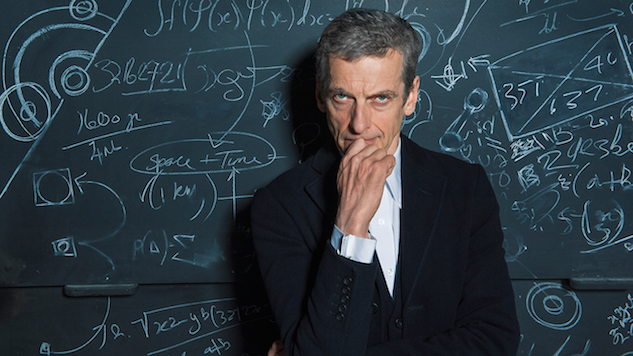
Creators: Sydney Newman, C. E. Webber, Donald Wilson
Stars: Christopher Eccleston, David Tennant, Matt Smith
Network: BBC
To begin his second season in the titular role of Doctor Who, Peter Capaldi appeared out of the mist driving a tank, wearing Ray-Bans and strapped to a knock-off Fender Stratocaster. It’s an anachronism in so many ways, not least of which in that the scene is set in the English village of Essex in the year 1138. Anachronisms are just part of the DNA of the show, as the Doctor lives across space and time, anchored to present-day England only by his traveling companion, who may need to get back from a Viking-era village or the moon or a space-train centuries into the future in time to teach school. Each episode or two-part arc not only takes place in a different time and location, but often shifts into a different genre, from slapstick action-comedy to moving philosophical drama to some of the most memorable horror elements to ever hit the small screen (like the Weeping Angels, terrifying statutes who only move when you’re not looking at them). An iconic series during its original run on the BBC from 1963 to 1989, the show began with an educational mission to introduce its family audience to both British history and science, and so often alternated between episodes set in the past and future. When it was revived in 2005 by executive producer Russell T. Davies, Doctor Who episodes remained varied, but with larger arcs following the Ninth and Tenth Doctors as they traveled across the history of the universe. When Stephen Moffat, who’d been writing for the show since 2005, took over as showrunner in 2010, creating with that kind of unpredictability for Doctors #11 (Matt Smith) and #12 (Capaldi) was paramount. Dinosaurs in space. Ghosts on an underwater base. Robots in Sherwood Forest. And plenty of the shows’ most iconic monsters, like the Daleks and Cybermen. Soon, there’ll be a new Doctor—Jodie Whittaker, the first woman to play the role—to continue, and evolve, the tradition. And as long as the story is good and the Doctor is traveling through an old, blue police box that’s bigger on the inside, audiences will tune in across the globe. —Josh Jackson
2. Star Trek: The Next Generation (1987-1994)

Creator: Gene Roddenberry
Stars: Patrick Stewart, Brent Spiner, Jonathan Frakes, LeVar Burton, Gates McFadden, Michael Dorn, Marina Sirtis, Wil Wheaton
Network: Syndicated
Star Trek: The Next Generation had a lot to overcome in its first couple of years. Besides having to live in the shadow of its legendary predecessor, the show suffered through a admittedly poor first season before finally finding its footing in year two. Subsequent episodes would deliver countless hours of entertaining and thought-provoking science-ficion, particularly with the addition of future Battlestar Galactica showrunner Ronald D. Moore in season three. After seven seasons and one of the most satisfying finales in TV history, the only question remaining is, great Star Trek series or greatest Star Trek series? The debate will always rage on endlessly, but I think time has been especially kind to peoples’ fondness for Next Generation, to the point where I expect it would be the winner of a poll of 1,000 Trekkies. And with good reason—TNG basically takes the original Star Trek’s exploration premise and goes further with it, expanding the boundaries of the universe and creating a richer, more compelling backdrop to the action. Everyone loves Patrick Stewart as the empathetic, cordial Captain Picard; the dude’s appeal is universal. Likewise, there are so many other fan-favorite characters, from good-guy Klingon warrior Worf to Brent Spiner as the charming android, Data. It’s probably the best pure cast in terms of acting talent that any entry in the series has ever had. Its reruns still draw good ratings—what other sci-fi show that started airing in 1987 can make that claim? —Mark Rozeman and Jim Vorel
1. Battlestar Galactica (2003-2009)

Creators: Glen A. Larson (original), Ronald D. Moore, David Eick
Stars: Edward James Olmos, Mary McDonnell, Katee Sackhoff, Jamie Bamber, James Callis, Michael Hogan, Aaron Douglas, Tricia Heifer, Grace Park, Tahmoh Penikett
Network: SyFy
There’s often a dichotomy in art between the epic and the personal. Smaller stories, those dealing with the kinds of challenges we regularly experience-family, romance, friendship, work, money-connect because they’re familiar. We watch epic films like Braveheart or Lord of the Rings to get caught up in struggles much greater than we face and vicariously inherit the satisfaction of seeing them overcome. But we read novels with minimal plots to see people like ourselves make the same stupid mistakes we do and come out on the other side having changed. Science fiction is almost entirely the domain of epic stories-working through a relationship gets completely overshadowed with the fate of humanity on the line. This is one of the main things sci-fi fans love about the genre and also what many people hate about it. So when people say that Battlestar Galactica is a show with a broader appeal than sci-fi, this is partly what they’re getting at.
Certainly, it’s an epic tale-it begins with the near annihilation of humanity, a culture spread across 12 planets but with many similarities to 21st-century Earth. The villains are Cylons, intelligent robots who believe that human extinction is the key to their own survival. And nearly every episode takes place aboard a single spaceship. On paper, it’s got everything to set off those with sci-fi allergies. But over seven seasons, it does a better job than any sci-fi film, book or TV show, of telling small stories. Unlike the Utopian crew of Star Trek’s Enterprise, each of the major characters has significant flaws. Even with only 50,000 survivors facing a single oppressor, humanity has a difficult time uniting. First, there’s the issue of the military taking control of a society used to its freedom. The tension between President Laura Roslyn (Mary McDonnell) and Commander William Adama (Edward James Olmos) is among the show’s most compelling threads. An inexperienced education minister, Rosyln finds herself promoted to the top post when no other senior government officials survive the initial attack. She pushes for a restoration to democracy, while Adama is hesitant to reliquish any decision-making in the face of the Cylon threat. Complicating things are Roslyn’s religious visions-a controversial experience among polytheistic cultures of varying degrees of observance. The challenges the leaders face are of a higher magnitude than we’ve experienced on earth, but the moral squirming and self-justification are all too familiar in politics today.
Creator Ronald D. Moore took the bare bones of a campy 1970s series and completely reimagined it, bringing a realism that sci-fi hadn’t quite seen before. The ship itself is aging and cramped. Quarters are claustrophobic, leading their inhabitants to live in a hyper-sensitive fishbowl-everyone is in everyone else’s business. Characters like Kara “Starbuck” Thrace (Katee Sackhoff) and Adama’s son Lee “Apollo” (Jamie Bamber) are forced to drag their emotional baggage into the uncomfortable open, which frequently causes them to snap. Ordinary life-love, marriage and raising kids-doesn’t cease just because there’s a war going on. Rosyln keeps a whiteboard with an updated population count, and each of the principle characters changes with every right or wrong decision.
But where Battlestar Galactica trumps other sci-fi stories in the minutia, it also beats them at their own epic game. Each season propels the main story arc along at light speed. A limited number of Cylon models are perfect human replicas-”skinjobs” who’ve infiltrated the human fleet. Their relationship with humanity grows more complex as disagreement arises within their ranks. And humanity’s search for the mythical Earth is full of constant surprises. Nearly every season is better than the last (even the misguided mess of a finale has its emotionally wrenching moments). With no alien civilizations to discover, Moore turns his lens inward on the species we know best. All the tensions in life are examined: religion vs. science, safety vs. freedom, the needs of the many vs. the needs of the few, conscience vs. loyalty, passion vs. commitment. And the show’s big question—”What does it mean to be human?”—is explored on every level, big and small. —Josh Jackson
